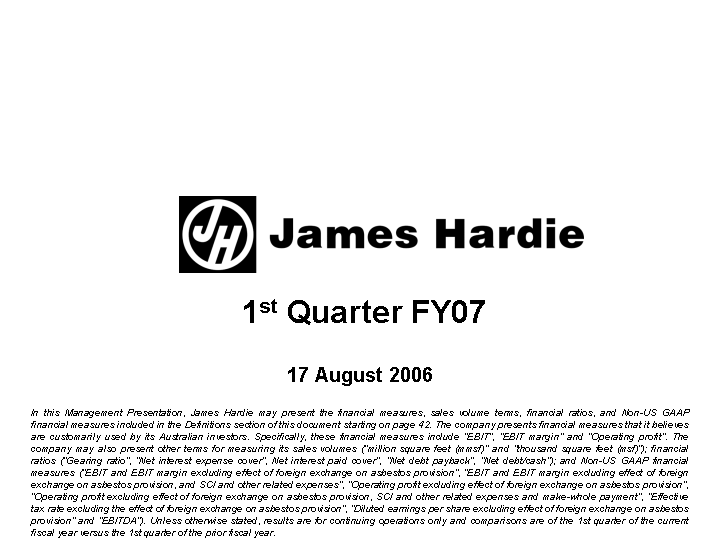
| Three Months Ended 30 June | ||||||||||||||||
| 2006 | 2005 | |||||||||||||||
| Key Information | US$M | US$M | Movement | |||||||||||||
Net Sales From Ordinary Activities |
415.5 | 359.4 | up | 16 | % | |||||||||||
Operating Profit From Operations After Tax
Attributable to Shareholders |
35.5 | 55.9 | down | 36 | % | |||||||||||
Net Tangible Assets per Ordinary Share |
US$ | 0.24 | US$ | 1.42 | down | 83 | % | |||||||||
| 1. | Media Release | ||
| 2. | Results At A Glance | ||
| 3. | Management’s Analysis of Results | ||
| 4. | Consolidated Financial Statements | ||
| 5. | Management Presentation |
17 August 2006
|
Analyst and Media enquiries about results, | |
| please contact Steve Ashe on | ||
| Tel: 61 2 8274 5246; Mob: 61 408 164 011 |
| US$ Million | Q1 FY07 | Q1 FY06 | %+/ (-) | |||||||||
Net sales |
$ | 415.5 | $ | 359.4 | 16 | |||||||
Gross profit |
157.7 | 145.3 | 9 | |||||||||
SCI and other related expenses |
(2.4 | ) | (5.2 | ) | (54 | ) | ||||||
EBIT excluding effect of foreign exchange on asbestos provision |
96.1 | 86.9 | 11 | |||||||||
Effect of foreign exchange on asbestos provision |
(27.2 | ) | — | — | ||||||||
EBIT |
68.9 | 86.9 | (21 | ) | ||||||||
Net interest expense |
(2.0 | ) | (0.7 | ) | — | |||||||
Income tax expense |
(32.3 | ) | (30.3 | ) | — | |||||||
Operating profit |
35.5 | 55.9 | (36 | ) | ||||||||
| US$ Million | Q1 FY07 | Q1 FY06 | % Change | |||||||||
Operating profit |
$ | 35.5 | $ | 55.9 | (36 | ) | ||||||
Effect of foreign exchange on asbestos provision |
27.2 | — | — | |||||||||
Operating profit excluding effect of foreign
exchange on asbestos provision |
62.7 | 55.9 | 12 | |||||||||
SCI and other related expenses (net of tax) |
2.2 | 4.9 | (55 | ) | ||||||||
Make-whole payment (net of tax) |
5.6 | — | — | |||||||||
Operating profit excluding effect of foreign
exchange on asbestos provision, SCI and other
related expenses and make-whole payment |
$ | 70.5 | $ | 60.8 | 16 | |||||||
2
3
| A$ to US$ | ||||||||||||
| Asbestos Provision | A$ millions | rate | US$ millions | |||||||||
At 31 March 2006 |
A$1,000.0 | 1.3975 to1 | $ | 715.6 | ||||||||
Effect of foreign exchange |
— | 27.2 | ||||||||||
At 30 June 2006 |
A$1,000.0 | 1.3463 to1 | $ | 742.8 | ||||||||
4
| 1 | Includes: ABN Amro, Citigroup, Credit Suisse, Deutsche Bank, Goldman Sachs JB Were, Macquarie Research, Merill Lynch, UBS |
5
Telephone:
|
61 2 8274 5246 | |
Mobile:
|
61 408 164 011 | |
Email:
|
[email protected] | |
Facsimile:
|
61 2 8274 5218 |
6
| Q1 | Q1 | |||||||
| US$ Million | FY07 | FY06 | ||||||
EBIT |
$ | 68.9 | $ | 86.9 | ||||
Effect of foreign exchange on asbestos provision |
27.2 | — | ||||||
EBIT excluding effect of foreign exchange on
asbestos provision |
96.1 | 86.9 | ||||||
Net Sales |
$ | 415.5 | $ | 359.4 | ||||
EBIT margin excluding effect of foreign exchange on
asbestos provision |
23.1 | % | 24.2 | % | ||||
7
| Q1 | Q1 | |||||||
| US$ Million | FY07 | FY06 | ||||||
EBIT |
$ | 68.9 | $ | 86.9 | ||||
Effect of foreign exchange on asbestos provision |
27.2 | — | ||||||
SCI and other related expenses |
2.4 | 5.2 | ||||||
EBIT excluding effect of foreign exchange on asbestos
provision and SCI and other related expenses |
$ | 98.5 | $ | 92.1 | ||||
| Q1 | Q1 | |||||||
| US$ Million | FY07 | FY06 | ||||||
Operating profit |
$ | 35.5 | $ | 55.9 | ||||
Effect of foreign exchange on asbestos provision |
27.2 | — | ||||||
Operating profit excluding effect of foreign
exchange on asbestos provision |
$ | 62.7 | $ | 55.9 | ||||
| Q1 | Q1 | |||||||
| US$ Million (except share and per share data) | FY07 | FY06 | ||||||
Operating profit |
$ | 35.5 | $ | 55.9 | ||||
Effect of foreign exchange on asbestos provision |
27.2 | — | ||||||
Operating profit excluding effect of foreign exchange
on asbestos provision |
62.7 | 55.9 | ||||||
Weighted average common shares outstanding (Millions)
— Diluted |
466.9 | 462.7 | ||||||
Diluted earnings per share excluding effect of
foreign exchange on asbestos provision (US cents) |
13.4 | 12.1 | ||||||
8
| Q1 | Q1 | |||||||
| US$ Million | FY07 | FY06 | ||||||
Operating profit before income taxes |
$ | 66.9 | $ | 86.2 | ||||
Effect of foreign exchange on asbestos provision |
27.2 | — | ||||||
Operating profit excluding effect of foreign exchange
on asbestos provision |
94.1 | 86.2 | ||||||
Income tax expense |
32.3 | 30.3 | ||||||
Effective tax rate excluding effect of foreign
exchange on asbestos provision |
34.3 | % | 35.2 | % | ||||
| • | expectations that the conditions precedent to the Final Funding Agreement will be satisfied; | ||
| • | expectations about payments to a special purpose fund for the compensation of proven asbestos-related personal injury and death claims; | ||
| • | expectations concerning the company’s Australian Tax Office amended assessment; | ||
| • | expectations that the company’s credit facilities will be extended or renewed; | ||
| • | projections of operating results or financial condition; | ||
| • | statements regarding plans, objectives or goals, including those relating to competition, acquisitions, dispositions and products; | ||
| • | statements about future performance; and | ||
| • | statements about product or environmental liabilities. |
9
James Hardie |
||||||||||||||||||||
Net Sales |
Up | 16 | % | to | US$415.5m | |||||||||||||||
EBIT |
Down | 21 | % | to | US$68.9m | Up | 11 | % | to | US$96.1m | ||||||||||
Operating Profit |
Down | 36 | % | to | US$35.5m | Up | 12 | % | to | US$62.7m | ||||||||||
EBIT Margin |
Down | 7.6pts | to | 16.6% | Down | 2.5pts | to | 23.1% | ||||||||||||
USA Fibre Cement |
||||||||||||||||||||
Net Sales |
Up | 21 | % | to | US$348.9m | |||||||||||||||
EBIT |
Up | 10 | % | to | US$103.3m | |||||||||||||||
EBIT Margin |
Down | 3.1pts | to | 29.6% | ||||||||||||||||
Volume |
Up | 16 | % | to | 605.7 mmsf | |||||||||||||||
Asia Pacific Fibre Cement |
||||||||||||||||||||
Net Sales |
Down | 4 | % | to | US$59.2m | |||||||||||||||
EBIT |
Down | 17 | % | to | US$10.3m | |||||||||||||||
EBIT Margin |
Down | 2.7pts | to | 17.4% | ||||||||||||||||
Volume |
Down | — | to | 91.8 mmsf | ||||||||||||||||
Key Ratios |
||||||||
Diluted earnings per share |
7.6 cents | 13.4cents | ||||||
EBIT Margin |
16.6 | % | 23.1 | % | ||||
Return on Shareholders’ Funds
(Annualised) |
128.5 | % | 17.5 | % | ||||
Return on Capital Employed (Annualised) |
27.6 | % | 38.2 | % | ||||
Gearing Ratio |
(43.3 | )% | (4.8 | )% | ||||
Net Interest Expense Cover |
33.4x | 46.4x | ||||||
Net Interest Paid Cover |
12.5x | 17.4x | ||||||
1
| Q1 | Q1 | |||||||
| US$ Million | FY07 | FY06 | ||||||
EBIT |
$ | 68.9 | $ | 86.9 | ||||
Effect of foreign exchange on asbestos provision |
27.2 | — | ||||||
EBIT excluding effect of foreign exchange on
asbestos provision |
96.1 | 86.9 | ||||||
Net Sales |
$ | 415.5 | $ | 359.4 | ||||
EBIT margin excluding effect of foreign exchange on
asbestos provision |
23.1 | % | 24.2 | % | ||||
2
| Q1 | Q1 | |||||||
| US$ Million | FY07 | FY06 | ||||||
EBIT |
$ | 68.9 | $ | 86.9 | ||||
Effect of foreign exchange on asbestos provision |
27.2 | — | ||||||
SCI and other related expenses |
2.4 | 5.2 | ||||||
EBIT excluding asbestos-related fx losses, SCI and
other related expenses |
$ | 98.5 | $ | 92.1 | ||||
| Q1 | Q1 | |||||||
| US$ Million | FY07 | FY06 | ||||||
Operating profit |
$ | 35.5 | $ | 55.9 | ||||
Effect of foreign exchange on asbestos provision |
27.2 | — | ||||||
Operating profit excluding effect of foreign
exchange on asbestos provision |
$ | 62.7 | $ | 55.9 | ||||
| Q1 | Q1 | |||||||
| US$ Million (except share and per share data) | FY07 | FY06 | ||||||
Operating profit |
$ | 35.5 | $ | 55.9 | ||||
Effect of foreign exchange on asbestos provision |
27.2 | — | ||||||
Operating profit excluding effect of foreign exchange
on asbestos provision |
62.7 | 55.9 | ||||||
Weighted average common shares outstanding (Millions)
— Diluted |
466.9 | 462.7 | ||||||
Diluted earnings per share excluding effect of
foreign exchange on asbestos provision (US cents) |
13.4 | 12.1 | ||||||
3
4
| Three Months Ended 30 June | ||||||||||||
| US GAAP — US$ Million | FY 2007 | FY 2006 | % Change | |||||||||
Net Sales |
||||||||||||
USA Fibre Cement |
$ | 348.9 | $ | 287.5 | 21 | |||||||
Asia Pacific Fibre Cement |
59.2 | 61.7 | (4 | ) | ||||||||
Other |
7.4 | 10.2 | (27 | ) | ||||||||
Total Net Sales |
$ | 415.5 | $ | 359.4 | 16 | |||||||
Cost of goods sold |
(257.8 | ) | (214.1 | ) | 20 | |||||||
Gross profit |
157.7 | 145.3 | 9 | |||||||||
Selling, general and administrative expense |
(51.7 | ) | (45.5 | ) | 14 | |||||||
Research and development expense |
(7.5 | ) | (6.3 | ) | 19 | |||||||
Special Commission of Inquiry (SCI) & other related expenses |
(2.4 | ) | (5.2 | ) | (54 | ) | ||||||
Impairment loss on business held for sale |
— | (1.4 | ) | (100 | ) | |||||||
Effect of foreign exchange on asbestos provision |
(27.2 | ) | — | — | ||||||||
EBIT |
68.9 | 86.9 | (21 | ) | ||||||||
Net interest expense |
(2.0 | ) | (0.7 | ) | — | |||||||
Operating profit before income taxes |
66.9 | 86.2 | (22 | ) | ||||||||
Income tax expense |
(32.3 | ) | (30.3 | ) | 7 | |||||||
Operating Profit before cumulative effect of change in
accounting principle |
34.6 | 55.9 | (38 | ) | ||||||||
Cumulative effect of change in accounting principle for stock-based compensation, net of income tax benefit of US$0.4 million |
0.9 | — | — | |||||||||
Operating Profit |
$ | 35.5 | $ | 55.9 | (36 | ) | ||||||
Tax rate |
48.3 | % | 35.2 | % | — | |||||||
Volume (mmsf) |
||||||||||||
USA Fibre Cement |
605.7 | 523.4 | 16 | |||||||||
Asia Pacific Fibre Cement |
91.8 | 92.0 | — | |||||||||
Average net sales price per unit (per msf) |
||||||||||||
USA Fibre Cement |
US$ | 576 | US$ | 549 | 5 | |||||||
Asia Pacific Fibre Cement |
A$ | 862 | A$ | 873 | (1 | ) | ||||||
2
3
4
| A$ to US$ | ||||||||||||
| Asbestos Provision | A$ millions | rate | US$ millions | |||||||||
At 31 March 2006 |
1,000.0 | 1.3975 to1 | 715.6 | |||||||||
Effect of foreign exchange |
— | 27.2 | ||||||||||
At 30 June 2006 |
1,000.0 | 1.3463 to1 | 742.8 | |||||||||
| Q1 FY07 | Q1 FY06 | % Change | ||||||||||
USA Fibre Cement |
$ | 103.3 | $ | 94.1 | 10 | |||||||
Asia Pacific Fibre Cement |
10.3 | 12.4 | (17 | ) | ||||||||
Research & Development |
(4.6 | ) | (3.2 | ) | (44 | ) | ||||||
Other |
(2.7 | ) | (3.5 | ) | 23 | |||||||
General Corporate |
(10.2 | ) | (12.9 | ) | 21 | |||||||
Effect of foreign exchange on asbestos provision |
(27.2 | ) | — | |||||||||
EBIT |
68.9 | 86.9 | (21 | ) | ||||||||
Excluding: |
||||||||||||
Effect of foreign exchange on asbestos provision, |
27.2 | — | — | |||||||||
SCI and other related expenses |
2.4 | 5.2 | (54 | ) | ||||||||
EBIT excluding effect of foreign exchange on
asbestos provision, and SCI and other related
expenses |
$ | 98.5 | $ | 92.1 | 7 | |||||||
Net sales |
$ | 415.5 | $ | 359.4 | 16 | |||||||
EBIT margin excluding the effect of foreign
exchange on asbestos provision and SCI and other
related expenses |
23.7 | % | 25.6 | % | — | |||||||
5
6
| Q1 FY07 | Q1 FY06 | % Change | ||||||||||
Operating profit |
$ | 35.5 | $ | 55.9 | (36 | ) | ||||||
Excluding: |
||||||||||||
Effect of foreign exchange on asbestos provision |
27.2 | — | — | |||||||||
SCI and other related expenses (net of tax) |
2.2 | 4.9 | (55 | ) | ||||||||
Make-whole payment (net of tax) |
5.6 | — | — | |||||||||
Operating profit excluding effect of foreign
exchange on asbestos provision, SCI and other
related expenses and make-whole payment |
$ | 70.5 | $ | 60.8 | 16 | |||||||
7
| Effective | ||||||||||||
| Interest Rate | Total Facility | Principal | ||||||||||
| at | at | Drawn at | ||||||||||
| Description | 30 June 2006 | 30 June 2006 | 30 June 2006 | |||||||||
| (US$ millions) | ||||||||||||
US$ 364-day term
facilities, can be
drawn in US$, variable
interest rates based
on LIBOR plus margin,
can be repaid and
redrawn until June
2007 |
5.72 | % | $ | 110.0 | $ | 69.5 | ||||||
US$ term facilities,
can be drawn in US$,
variable interest
rates based on LIBOR
plus margin, can be
repaid and redrawn
until December 2006 |
5.88 | % | 245.0 | 67.5 | ||||||||
Total |
$ | 355.0 | $ | 137.0 | ||||||||
| Management’s Analysis of Results: James Hardie — 1st Quarter FY07 |
8
| • | the establishment of the SPF to compensate Australian asbestos-related personal injury claimants with proven claims against the former James Hardie Group subsidiaries (Amaca Pty Ltd, Amaba Pty Ltd or ABN 60 Pty Ltd); | |
| • | initial funding of the SPF by James Hardie of approximately A$154 million; | |
| • | a two-year rolling cash ‘buffer’ in the SPF and, subject to the cap described below, an annual contribution in advance to top up those funds to equal the actuarially calculated estimate of expected Australian asbestos-related personal injury claims against the former James Hardie Group subsidiaries for the following three years, to be revised annually; | |
| • | a cap on the annual James Hardie payments to the SPF in all years, except the first year, initially set at 35% of James Hardie’s free cash flow (defined as cash from operations in accordance with US accounting standards in force at the date of the FFA) for the immediately preceding financial year, with provisions for the percentage to decline over time, depending on James Hardie’s financial performance (and therefore the contributions already made to the SPF) and the claims outlook; | |
| • | no cap on individual payments to proven claimants; and | |
| • | special compensation arrangements for members of the Baryulgil community for asbestos-related claims arising from the activities of Marlew Mining Pty Ltd. |
| Management’s Analysis of Results: James Hardie — 1st Quarter FY07 |
9
Telephone:
|
61 2 8274 5246 | |
Mobile:
|
61 408 164 011 | |
Email:
|
[email protected] | |
Facsimile:
|
61 2 8274 5218 |
| Management’s Analysis of Results: James Hardie — 1st Quarter FY07 |
10
| Q1 | Q1 | |||||||
| US$ Million | FY07 | FY06 | ||||||
EBIT |
$ | 68.9 | $ | 86.9 | ||||
Effect of foreign exchange on asbestos provision |
27.2 | — | ||||||
EBIT excluding effect of foreign exchange on
asbestos provision |
96.1 | 86.9 | ||||||
Net Sales |
$ | 415.5 | $ | 359.4 | ||||
EBIT margin excluding effect of foreign exchange on
asbestos provision |
23.1 | % | 24.2 | % | ||||
| Management’s Analysis of Results: James Hardie — 1st Quarter FY07 |
11
| Q1 | Q1 | |||||||
| US$ Million | FY07 | FY06 | ||||||
EBIT |
$ | 68.9 | $ | 86.9 | ||||
Effect of foreign exchange on asbestos provision |
27.2 | — | ||||||
SCI and other related expenses |
2.4 | 5.2 | ||||||
EBIT excluding effect of foreign exchange on asbestos
provision and SCI and other related expenses |
$ | 98.5 | $ | 92.1 | ||||
| Q1 | Q1 | |||||||
| US$ Million | FY07 | FY06 | ||||||
Operating profit |
$ | 35.5 | $ | 55.9 | ||||
Effect of foreign exchange on asbestos provision |
27.2 | — | ||||||
Operating profit excluding effect of foreign
exchange on asbestos provision |
$ | 62.7 | $ | 55.9 | ||||
| Q1 | Q1 | |||||||
| US$ Million (except share and per share data) | FY07 | FY06 | ||||||
Operating profit |
$ | 35.5 | $ | 55.9 | ||||
Effect of foreign exchange on asbestos provision |
27.2 | — | ||||||
Operating profit excluding effect of foreign exchange
on asbestos provision |
62.7 | 55.9 | ||||||
Weighted average common shares outstanding (Millions)
— Diluted |
466.9 | 462.7 | ||||||
Diluted earnings per share excluding effect of
foreign exchange on asbestos provision (US cents) |
13.4 | 12.1 | ||||||
| Management’s Analysis of Results: James Hardie — 1st Quarter FY07 |
12
| Q1 | Q1 | |||||||
| US$ Million | FY07 | FY06 | ||||||
Operating profit before income taxes |
$ | 66.9 | $ | 86.2 | ||||
Effect of foreign exchange on asbestos provision |
27.2 | — | ||||||
Operating profit excluding effect of foreign exchange
on asbestos provision |
94.1 | 86.2 | ||||||
Income tax expense |
32.3 | 30.3 | ||||||
Effective tax rate excluding effect of foreign
exchange on asbestos provision |
34.3 | % | 35.2 | % | ||||
| Management’s Analysis of Results: James Hardie — 1st Quarter FY07 |
13
| Pro Forma | ||||||||||||
| Total Fibre | ||||||||||||
| Cement | Asbestos | |||||||||||
| US$ Million | Operations | Provision | As Reported | |||||||||
ASSETS |
||||||||||||
Current assets: |
||||||||||||
Cash and cash equivalents |
$ | 175.4 | $ | — | $ | 175.4 | ||||||
Accounts and notes receivable, net of
allowance for doubtful accounts of $1.4
million |
158.0 | — | 158.0 | |||||||||
Inventories |
136.9 | — | 136.9 | |||||||||
Prepaid expenses and other current assets |
38.6 | — | 38.6 | |||||||||
Deferred income taxes |
28.2 | — | 28.2 | |||||||||
Total current assets |
537.1 | — | 537.1 | |||||||||
Property, plant and equipment, net |
801.8 | — | 801.8 | |||||||||
Deferred income taxes |
5.4 | — | 5.4 | |||||||||
Other assets |
7.9 | — | 7.9 | |||||||||
Total assets |
$ | 1,352.2 | $ | — | $ | 1,352.2 | ||||||
LIABILITIES AND SHAREHOLDERS’ EQUITY |
||||||||||||
Current liabilities: |
||||||||||||
Accounts payable and accrued liabilities |
$ | 114.5 | $ | — | $ | 114.5 | ||||||
Short-term debt |
137.0 | — | 137.0 | |||||||||
Dividends payable |
18.7 | — | 18.7 | |||||||||
Accrued payroll and employee benefits |
37.2 | — | 37.2 | |||||||||
Accrued product warranties |
7.6 | — | 7.6 | |||||||||
Income taxes payable |
33.1 | — | 33.1 | |||||||||
Other liabilities |
3.2 | — | 3.2 | |||||||||
Total current liabilities |
351.3 | — | 351.3 | |||||||||
Deferred income taxes |
86.8 | — | 86.8 | |||||||||
Accrued product warranties |
7.5 | — | 7.5 | |||||||||
Asbestos provision |
— | 742.8 | 742.8 | |||||||||
Other liabilities |
51.0 | — | 51.0 | |||||||||
Total liabilities |
496.6 | 742.8 | 1,239.4 | |||||||||
Commitments and contingencies |
||||||||||||
Shareholders’ equity |
||||||||||||
Common stock, Euro 0.59 par value, 2.0
billion shares authorised; 463,326,011 shares
issued and outstanding |
253.2 | — | 253.2 | |||||||||
Additional paid-in capital |
159.2 | — | 159.2 | |||||||||
Retained earnings (deficit) |
471.3 | (742.8 | ) | (271.5 | ) | |||||||
Employee loans |
(0.4 | ) | — | (0.4 | ) | |||||||
Accumulated other comprehensive loss |
(27.7 | ) | — | (27.7 | ) | |||||||
Total shareholders’ equity |
855.6 | (742.8 | ) | 112.8 | ||||||||
Total liabilities and shareholders’
equity |
$ | 1,352.2 | $ | — | $ | 1,352.2 | ||||||
| Management’s Analysis of Results: James Hardie — 1st Quarter FY07 |
14
| James Hardie Industries N.V. | ||
| Consolidated Statement of Operations | ||
| For the three months ended 30 June 2006 | ||
| (Unaudited) |
| Pro Forma | ||||||||||||
| Total Fibre | ||||||||||||
| Cement | Asbestos | |||||||||||
| US$ Million | Operations | Provision | As Reported | |||||||||
Net Sales |
||||||||||||
USA Fibre Cement |
$ | 348.9 | $ | — | $ | 348.9 | ||||||
Asia Pacific Fibre Cement |
59.2 | — | 59.2 | |||||||||
Other |
7.4 | — | 7.4 | |||||||||
Total Net Sales |
415.5 | — | 415.5 | |||||||||
Cost of goods sold |
(257.8 | ) | — | (257.8 | ) | |||||||
Gross profit |
157.7 | — | 157.7 | |||||||||
Selling, general and administrative expenses |
(51.7 | ) | — | (51.7 | ) | |||||||
Research and development expenses |
(7.5 | ) | — | (7.5 | ) | |||||||
SCI and other related expenses |
(2.4 | ) | — | (2.4 | ) | |||||||
Effect of foreign exchange on asbestos provision |
— | (27.2 | ) | (27.2 | ) | |||||||
EBIT |
96.1 | (27.2 | ) | 68.9 | ||||||||
Net interest expense |
(2.0 | ) | — | (2.0 | ) | |||||||
Operating profit before income taxes |
94.1 | (27.2 | ) | 66.9 | ||||||||
Income tax expense |
(32.3 | ) | — | (32.3 | ) | |||||||
Operating Profit Before Cumulative Effect of Change in
Accounting Principle |
61.8 | (27.2 | ) | 34.6 | ||||||||
Cumulative effect of change in accounting principle for stock-based compensation (net of US$0.4 million tax) |
0.9 | — | 0.9 | |||||||||
Operating Profit |
$ | 62.7 | $ | (27.2 | ) | $ | 35.5 | |||||
Effective Tax Rate |
34.3 | % | — | 48.3 | % | |||||||
Volume (mmsf) |
||||||||||||
USA Fibre Cement |
605.7 | — | 605.7 | |||||||||
Asia Pacific Fibre Cement |
91.8 | — | 91.8 | |||||||||
Average net sales price per unit (per msf) |
— | |||||||||||
USA Fibre Cement |
US$ | 576 | — | US$ | 576 | |||||||
Asia Pacific Fibre Cement |
A$ | 862 | — | A$ | 862 | |||||||
| Management’s Analysis of Results: James Hardie — 1st Quarter FY07 |
15
| James Hardie Industries N.V | ||
| Consolidated Statement of Cash Flows | ||
| For the three months ended 30 June 2006 | ||
| (Unaudited) |
| Pro Forma | ||||||||||||
| Total Fibre | ||||||||||||
| Cement | Asbestos | |||||||||||
| US $ Million | Operations | Provision | As Reported | |||||||||
Cash Flows From Operating Activities |
||||||||||||
Net income (loss) |
$ | 62.7 | $ | (27.2 | ) | $ | 35.5 | |||||
Adjustments to reconcile net income (loss) to net cash provided
by operating activities: |
||||||||||||
Depreciation and amortisation |
11.0 | — | 11.0 | |||||||||
Deferred income taxes |
9.0 | — | 9.0 | |||||||||
Prepaid pension cost |
0.7 | — | 0.7 | |||||||||
Stock compensation |
0.2 | — | 0.2 | |||||||||
Effect of foreign exchange on asbestos provision |
— | 27.2 | 27.2 | |||||||||
Cumulative effect of change in accounting principle |
(0.9 | ) | — | (0.9 | ) | |||||||
Changes in operating assets and liabilities: |
||||||||||||
Accounts and notes receivable |
(3.9 | ) | — | (3.9 | ) | |||||||
Inventories |
(12.2 | ) | — | (12.2 | ) | |||||||
Prepaid expenses and other current assets |
(5.5 | ) | — | (5.5 | ) | |||||||
Accounts payable and accrued liabilities |
(3.9 | ) | — | (3.9 | ) | |||||||
Other accrued liabilities and other liabilities |
3.5 | — | 3.5 | |||||||||
Net cash provided by operating activities |
60.7 | — | 60.7 | |||||||||
Cash Flows From Investing Activities |
||||||||||||
Purchases of property, plant and equipment |
(35.5 | ) | — | (35.5 | ) | |||||||
Net cash used in investing activities |
(35.5 | ) | — | (35.5 | ) | |||||||
Cash Flows From Financing Activities |
||||||||||||
Repayments of long and short-term debt |
(165.7 | ) | — | (165.7 | ) | |||||||
Issuance of shares |
0.2 | — | 0.2 | |||||||||
Net cash used in financing activities |
(165.5 | ) | — | (165.5 | ) | |||||||
Effects of exchange rate changes on cash |
0.6 | — | 0.6 | |||||||||
Net decrease in cash and cash equivalents |
(139.7 | ) | — | (139.7 | ) | |||||||
Cash and cash equivalents at beginning of period |
315.1 | — | 315.1 | |||||||||
Cash and cash equivalents at end of period |
$ | 175.4 | $ | — | $ | 175.4 | ||||||
Components of Cash and Cash Equivalents |
||||||||||||
Cash at bank and on hand |
$ | 23.6 | $ | — | $ | 23.6 | ||||||
Short-term deposits |
151.8 | — | 151.8 | |||||||||
Cash and cash equivalents at end of period |
$ | 175.4 | $ | — | $ | 175.4 | ||||||
| Management’s Analysis of Results: James Hardie — 1st Quarter FY07 |
16
| • | expectations that the conditions precedent to the Final Funding Agreement will be satisfied; | ||
| • | expectations about payments to a special purpose fund for the compensation of proven asbestos-related personal injury and death claims; | ||
| • | expectations concerning the company’s Australian Tax Office amended assessment; | ||
| • | expectations that the company’s credit facilities will be extended or renewed; | ||
| • | projections of operating results or financial condition; | ||
| • | statements regarding plans, objectives or goals, including those relating to competition, acquisitions, dispositions and products; | ||
| • | statements about future performance; and | ||
| • | statements about product or environmental liabilities. |
| Management’s Analysis of Results: James Hardie — 1st Quarter FY07 |
17
| Page | ||||
Item 1. Condensed Financial Statements (Unaudited) |
||||
Condensed Consolidated Balance Sheets as of 30 June 2006 and 31 March 2006 |
F-3 | |||
Condensed Consolidated Statements of Operations for the Three Months Ended 30 June
2006 and 2005 |
F-4 | |||
Condensed Consolidated Statements of Cash Flows for the Three Months Ended 30 June
2006 and 2005 |
F-6 | |||
Condensed Consolidated Statements of Changes in Shareholders’ Equity for the Three
Months Ended 30 June 2006 |
F-8 | |||
Notes to Condensed Consolidated Financial Statements |
F-9 | |||
Item 2. Quantitative and Qualitative Disclosures About Market Risk |
30 | |||
| Millions of | Millions of | |||||||||||||||
| US Dollars | Australian Dollars | |||||||||||||||
| 30 June | 31 March | 30 June | 31 March | |||||||||||||
| 2006 | 2006 | 2006 | 2006 | |||||||||||||
Assets |
||||||||||||||||
Current assets: |
||||||||||||||||
Cash and cash equivalents |
$ | 175.4 | $ | 315.1 | A$ | 236.1 | A$ | 440.4 | ||||||||
Accounts and notes receivable, net of
allowance for
doubtful accounts of $1.4 million
(A$1.9 million) and
$1.3 million (A$1.8 million) as of 30
June 2006
and 31 March 2006, respectively |
158.0 | 153.2 | 212.7 | 214.1 | ||||||||||||
Inventories |
136.9 | 124.0 | 184.3 | 173.3 | ||||||||||||
Prepaid expenses and other current assets |
38.6 | 33.8 | 52.0 | 47.2 | ||||||||||||
Deferred income taxes |
28.2 | 30.7 | 38.0 | 42.9 | ||||||||||||
Total current assets |
537.1 | 656.8 | 723.1 | 917.9 | ||||||||||||
Property, plant and equipment, net |
801.8 | 775.6 | 1,079.5 | 1,083.9 | ||||||||||||
Deferred income taxes |
5.4 | 4.8 | 7.3 | 6.7 | ||||||||||||
Other assets |
7.9 | 8.2 | 10.6 | 11.5 | ||||||||||||
Total assets |
$ | 1,352.2 | $ | 1,445.4 | A$ | 1,820.5 | A$ | 2,020.0 | ||||||||
Liabilities and Shareholders’ Equity |
||||||||||||||||
Current liabilities: |
||||||||||||||||
Accounts payable and accrued liabilities |
$ | 114.5 | $ | 117.8 | A$ | 154.2 | A$ | 164.6 | ||||||||
Current portion of long-term debt |
— | 121.7 | — | 170.1 | ||||||||||||
Short-term debt |
137.0 | 181.0 | 184.4 | 252.9 | ||||||||||||
Dividends payable |
18.7 | — | 25.2 | — | ||||||||||||
Accrued payroll and employee benefits |
37.2 | 46.3 | 50.1 | 64.7 | ||||||||||||
Accrued product warranties |
7.6 | 11.4 | 10.2 | 15.9 | ||||||||||||
Income taxes payable |
33.1 | 24.5 | 44.6 | 34.2 | ||||||||||||
Other liabilities |
3.2 | 3.3 | 4.3 | 4.6 | ||||||||||||
Total current liabilities |
351.3 | 506.0 | 473.0 | 707.0 | ||||||||||||
Deferred income taxes |
86.8 | 79.8 | 116.9 | 111.5 | ||||||||||||
Accrued product warranties |
7.5 | 4.1 | 10.1 | 5.7 | ||||||||||||
Asbestos provision |
742.8 | 715.6 | 1,000.0 | 1,000.0 | ||||||||||||
Other liabilities |
51.0 | 45.0 | 68.7 | 62.9 | ||||||||||||
Total liabilities |
1,239.4 | 1,350.5 | A$ | 1,668.7 | A$ | 1,887.1 | ||||||||||
Commitments and contingencies (Note 7) |
||||||||||||||||
Shareholders’ equity: |
||||||||||||||||
Common stock, Euro 0.59 par value, 2.0
billion
shares authorised; 463,326,011 shares issued
and outstanding at 30 June 2006 and
463,306,511 shares issued and outstanding
at 31 March 2006 |
$ | 253.2 | $ | 253.2 | ||||||||||||
Additional paid-in capital |
159.2 | 158.8 | ||||||||||||||
Accumulated deficit |
(271.5 | ) | (288.3 | ) | ||||||||||||
Employee loans |
(0.4 | ) | (0.4 | ) | ||||||||||||
Accumulated other comprehensive loss |
(27.7 | ) | (28.4 | ) | ||||||||||||
Total shareholders’ equity |
112.8 | 94.9 | ||||||||||||||
Total liabilities and shareholders’
equity |
$ | 1,352.2 | $ | 1,445.4 | ||||||||||||
| Three Months | ||||||||
| Ended 30 June | ||||||||
| (Millions of US dollars, except per share data) | 2006 | 2005 | ||||||
Net sales |
$ | 415.5 | $ | 359.4 | ||||
Cost of goods sold |
(257.8 | ) | (214.1 | ) | ||||
Gross profit |
157.7 | 145.3 | ||||||
Selling, general and administrative expenses |
(51.7 | ) | (45.5 | ) | ||||
Research and development expenses |
(7.5 | ) | (6.3 | ) | ||||
SCI and other related expenses |
(2.4 | ) | (5.2 | ) | ||||
Impairment loss on business held for sale |
— | (1.4 | ) | |||||
Effect of foreign exchange on asbestos provision |
(27.2 | ) | — | |||||
Operating income |
68.9 | 86.9 | ||||||
Interest expense |
(5.6 | ) | (1.7 | ) | ||||
Interest income |
3.6 | 1.0 | ||||||
Income before income taxes |
66.9 | 86.2 | ||||||
Income tax expense |
(32.3 | ) | (30.3 | ) | ||||
Income before cumulative effect of change
in accounting principle |
34.6 | 55.9 | ||||||
Cumulative effect of change in accounting principle
for stock-based compensation (net of US$0.4 million of tax) |
0.9 | — | ||||||
Net income |
$ | 35.5 | $ | 55.9 | ||||
Net income per share — basic |
$ | 0.08 | $ | 0.12 | ||||
Net income per share — diluted |
$ | 0.08 | $ | 0.12 | ||||
Weighted average common shares outstanding
(Millions): |
||||||||
Basic |
463.3 | 460.6 | ||||||
Diluted |
466.9 | 462.7 | ||||||
| Three Months | ||||||||
| Ended 30 June | ||||||||
| (Millions of Australian dollars, except per share data) | 2006 | 2005 | ||||||
Net sales |
A$ | 556.1 | A$ | 467.6 | ||||
Cost of goods sold |
(345.0 | ) | (278.5 | ) | ||||
Gross profit |
211.1 | 189.1 | ||||||
Selling, general and administrative expenses |
(69.2 | ) | (59.2 | ) | ||||
Research and development expenses |
(10.0 | ) | (8.2 | ) | ||||
SCI and other related expenses |
(3.2 | ) | (6.8 | ) | ||||
Impairment loss on business held for sale |
— | (1.8 | ) | |||||
Effect of foreign exchange on asbestos provision |
(36.4 | ) | — | |||||
Operating income |
92.3 | 113.1 | ||||||
Interest expense |
(7.5 | ) | (2.2 | ) | ||||
Interest income |
4.8 | 1.3 | ||||||
Income before income taxes |
89.6 | 112.2 | ||||||
Income tax expense |
(43.3 | ) | (39.4 | ) | ||||
Income before cumulative effect of change in accounting principle |
46.3 | 72.8 | ||||||
Cumulative effect of change in accounting principle for stock-based
compensation (net of A$0.5 million of tax) |
1.2 | — | ||||||
Net income |
A$ | 47.5 | A$ | 72.8 | ||||
Net income per share — basic |
A$ | 0.10 | A$ | 0.16 | ||||
Net income per share — diluted |
A$ | 0.10 | A$ | 0.16 | ||||
Weighted average common shares outstanding
(Millions): |
||||||||
Basic |
463.3 | 460.6 | ||||||
Diluted |
466.9 | 462.7 | ||||||
F-5
| Three Months | ||||||||
| Ended 30 June | ||||||||
| (Millions of US dollars) | 2006 | 2005 | ||||||
Cash Flows From Operating Activities |
||||||||
Net income |
$ | 35.5 | $ | 55.9 | ||||
Adjustments to reconcile net income to net cash
provided by operating activities: |
||||||||
Impairment loss on business held for sale |
— | 1.4 | ||||||
Depreciation and amortisation |
11.0 | 9.4 | ||||||
Deferred income taxes |
9.0 | 7.3 | ||||||
Prepaid pension cost |
0.7 | 0.8 | ||||||
Stock compensation |
0.2 | 1.0 | ||||||
Effect of foreign exchange on asbestos provision |
27.2 | — | ||||||
Cumulative effect of change in accounting principle |
(0.9 | ) | — | |||||
Other |
— | 0.3 | ||||||
Changes in operating assets and liabilities: |
||||||||
Accounts and notes receivable |
(3.9 | ) | (16.2 | ) | ||||
Inventories |
(12.2 | ) | (6.4 | ) | ||||
Prepaid expenses and other current assets |
(5.5 | ) | (7.4 | ) | ||||
Accounts payable and accrued liabilities |
(3.9 | ) | 12.4 | |||||
Other accrued liabilities and other liabilities |
3.5 | 18.1 | ||||||
Net cash provided by operating activities |
60.7 | 76.6 | ||||||
Cash Flows From Investing Activities |
||||||||
Purchases of property, plant and equipment |
(35.5 | ) | (34.0 | ) | ||||
Net cash
used in investing activities |
(35.5 | ) | (34.0 | ) | ||||
Cash Flows From Financing Activities |
||||||||
Net proceeds from line of credit |
— | 0.6 | ||||||
Repayments of long-term debt |
(121.7 | ) | — | |||||
Repayments of short-term debt |
(44.0 | ) | — | |||||
Issuance of shares |
0.2 | 4.6 | ||||||
Tax benefit from stock options exercised |
— | 0.6 | ||||||
Collections on loans receivable |
— | 0.1 | ||||||
Net cash (used in) provided by financing activities |
(165.5 | ) | 5.9 | |||||
Effects of exchange rate changes on cash |
0.6 | (0.4 | ) | |||||
Net (decrease) increase in cash and cash equivalents |
(139.7 | ) | 48.1 | |||||
Cash and cash equivalents at beginning of period |
315.1 | 113.5 | ||||||
Cash and cash equivalents at end of period |
$ | 175.4 | $ | 161.6 | ||||
Components of Cash and Cash Equivalents |
||||||||
Cash at bank and on hand |
$ | 23.6 | $ | 53.5 | ||||
Short-term deposits |
151.8 | 108.1 | ||||||
Cash and cash equivalents at end of period |
$ | 175.4 | $ | 161.6 | ||||
F-6
| Three Months | ||||||||
| Ended 30 June | ||||||||
| (Millions of Australian dollars) | 2006 | 2005 | ||||||
Cash Flows From Operating Activities |
||||||||
Net income |
A$ | 47.5 | A$ | 72.8 | ||||
Adjustments to reconcile net income to net cash
provided by operating activities: |
||||||||
Impairment loss on business held for sale |
— | 1.8 | ||||||
Depreciation and amortisation |
14.7 | 12.2 | ||||||
Deferred income taxes |
12.0 | 9.5 | ||||||
Prepaid pension cost |
0.9 | 1.0 | ||||||
Stock compensation |
0.3 | 1.3 | ||||||
Effect of foreign exchange on asbestos provision |
36.5 | — | ||||||
Cumulative effect of change in accounting principle |
(1.3 | ) | — | |||||
Other |
— | 0.4 | ||||||
Changes in operating assets and liabilities: |
||||||||
Accounts and notes receivable |
(5.2 | ) | (21.1 | ) | ||||
Inventories |
(16.3 | ) | (8.3 | ) | ||||
Prepaid expenses and other current assets |
(7.4 | ) | (9.6 | ) | ||||
Accounts payable and accrued liabilities |
(5.2 | ) | 16.1 | |||||
Other accrued liabilities and other liabilities |
4.7 | 23.5 | ||||||
Net cash provided by operating activities |
81.2 | 99.6 | ||||||
Cash Flows From Investing Activities |
||||||||
Purchases of property, plant and equipment |
(47.6 | ) | (44.2 | ) | ||||
Net cash used in investing activities |
(47.6 | ) | (44.2 | ) | ||||
Cash Flows From Financing Activities |
||||||||
Net proceeds from line of credit |
— | 0.8 | ||||||
Repayments of long-term debt |
(162.9 | ) | — | |||||
Repayments of short-term debt |
(58.9 | ) | — | |||||
Issuance of shares |
0.3 | 6.0 | ||||||
Tax benefit from stock options exercised |
— | 0.8 | ||||||
Collections on loans receivable |
— | 0.1 | ||||||
Net cash (used in) provided by financing activities |
(221.5 | ) | 7.7 | |||||
Effects of exchange rate changes on cash |
(16.4 | ) | 1.6 | |||||
Net (decrease) increase in cash and cash equivalents |
(204.3 | ) | 64.7 | |||||
Cash and cash equivalents at beginning of period |
440.4 | 146.9 | ||||||
Cash and cash equivalents at end of period |
A$ | 236.1 | A$ | 211.6 | ||||
Components of Cash and Cash Equivalents |
||||||||
Cash at bank and on hand |
A$ | 31.8 | A$ | 70.0 | ||||
Short-term deposits |
204.4 | 141.6 | ||||||
Cash and cash equivalents at end of period |
A$ | 236.1 | A$ | 211.6 | ||||
F-7
| Accumulated | ||||||||||||||||||||||||
| Additional | Other | |||||||||||||||||||||||
| Common | Paid-in | Accumulated | Employee | Comprehensive | ||||||||||||||||||||
| (Millions of US dollars) | Stock | Capital | Deficit | Loans | (Loss) Income | Total | ||||||||||||||||||
Balances as of 31 March 2006 |
$ | 253.2 | $ | 158.8 | $ | (288.3 | ) | $ | (0.4 | ) | $ | (28.4 | ) | $ | 94.9 | |||||||||
Comprehensive Income: |
||||||||||||||||||||||||
Net income |
— | — | 35.5 | — | — | 35.5 | ||||||||||||||||||
Other comprehensive income: |
||||||||||||||||||||||||
Foreign currency translation |
— | — | — | — | 0.7 | 0.7 | ||||||||||||||||||
Total comprehensive income |
36.2 | |||||||||||||||||||||||
Dividends declared |
— | — | (18.7 | ) | — | — | (18.7 | ) | ||||||||||||||||
Stock compensation |
— | 0.2 | — | — | — | 0.2 | ||||||||||||||||||
Stock options exercised |
— | 0.2 | — | — | — | 0.2 | ||||||||||||||||||
Balances as of 30 June 2006 |
$ | 253.2 | $ | 159.2 | $ | (271.5 | ) | (0.4 | ) | $ | (27.7 | ) | $ | 112.8 | ||||||||||
F-8
| 1. | Basis of Presentation | |
| Nature of Operations | ||
| The Company manufactures and sells fibre cement building products for interior and exterior building construction applications primarily in the United States, Australia, New Zealand, Philippines and Europe. | ||
| Basis of Presentation | ||
| The consolidated financial statements represent the financial position, results of operations and cash flows of James Hardie Industries N.V. (“JHI NV”) and its current wholly owned subsidiaries, collectively referred to as either the “Company” or “James Hardie” and JHI NV together with its subsidiaries as of the time relevant to the applicable reference, the “James Hardie Group,” unless the context indicates otherwise. | ||
| The assets, liabilities, statement of operations and statements of cash flows of the Company have been presented with accompanying Australian dollar (A$) convenience translations as the majority of the Company’s shareholder base is Australian. These A$ convenience translations are not prepared in accordance with accounting principles generally accepted in the United States of America. The exchange rates used to calculate the convenience translations are as follows: |
| 31 March | 30 June | |||||||||||
| (US$1 = A$) | 2006 | 2006 | 2005 | |||||||||
Assets and liabilities |
1.3975 | 1.3463 | 1.3092 | |||||||||
Income statement |
n/a | 1.3383 | 1.3010 | |||||||||
Cash flows — beginning cash |
n/a | 1.3975 | 1.2946 | |||||||||
Cash flows — ending cash |
n/a | 1.3463 | 1.3092 | |||||||||
Cash flows — current period movements |
n/a | 1.3383 | 1.3010 | |||||||||
| The asbestos provision on the A$ unaudited consolidated statements of operations and A$ unaudited consolidated statements of cash flows is the difference in the balance sheet rate at 30 June and 31 March 2006 respectively, translated using the assets and liabilities rate at 31 March 2006. | ||
| 2. | Summary of Significant Accounting Policies | |
| Earnings Per Share | ||
| The Company is required to disclose basic and diluted earnings per share (“EPS”). Basic EPS is calculated using income divided by the weighted average number of common shares outstanding during the period. Diluted EPS is similar to basic EPS except that the weighted average number of common shares outstanding is increased to include the number of additional common shares calculated using the treasury method that would have been outstanding if dilutive potential common shares, such as options, had been exercised. Accordingly, basic and dilutive common shares outstanding used in determining net income per share are as follows: |
F-9
| Three Months | ||||||||
| Ended 30 June | ||||||||
| (Millions of shares) | 2006 | 2005 | ||||||
Basic common shares outstanding |
463.3 | 460.6 | ||||||
Dilutive effect of stock options |
3.6 | 2.1 | ||||||
Diluted common shares outstanding |
466.9 | 462.7 | ||||||
| US dollars | 2006 | 2005 | ||||||
Net income per share — basic |
$ | 0.08 | $ | 0.12 | ||||
Net income per share — diluted |
$ | 0.08 | $ | 0.12 | ||||
| Potential common shares of 6.5 million and 4.5 million for the three months ended 30 June 2006 and 2005, respectively, have been excluded from the calculations of diluted common shares outstanding because the effect of their inclusion would be anti-dilutive. | ||
| Advertising | ||
| The Company expenses the production costs of advertising the first time the advertising takes place. Advertising expense was US$4.3 million and US$4.4 million for the three months ended 30 June 2006 and 2005, respectively. | ||
| Stock-Based Compensation | ||
| The Company implemented the provisions of SFAS No. 123, Accounting for Stock-Based Compensation, using the Retroactive Restatement method provided by SFAS No. 148, Accounting for Stock-Based Compensation – Transition and Disclosure – an amendment SFAS No. 123. When SFAS No. 123 was adopted the Retroactive Restatement method required the restatement of prior periods’ reported net income to give effect to the fair value based method of accounting for awards granted, modified, or settled in fiscal years beginning after 15 December 1994. Therefore, no transition adjustments are required upon the Company adopting SFAS No. 123R. In adoption this standard the Company has employed the modified prospective transition method. | ||
| SFAS No. 123R requires that a Company estimate forfeitures of stock options at the date of grant rather than allowing the Company to account for forfeitures as they occur. At the time the Company adopted SFAS No. 123, it decided to account for forfeitures as they occur primary due to the limited historical data to accurately estimate a forfeiture rate at the date of grant. Paragraph 80 of SFAS No. 123 states, “As of the required effective date, an entity that had a policy or recognising the effect of forfeitures only as they occurred shall estimate the number of outstanding instrument for which the requisite service is not expected to be rendered. Balance sheet amounts related to any compensation cost (excluding non-refundable divided payments), net of related tax effects, for those instrument previously recognised in income because of that policy for periods before the effective date of SFAS No. 123R shall be eliminated and recognised in income as the cumulative effect of a change in accounting principle as of the required effective date.” | ||
| The Company recognised stock-based compensation expense (included in Selling, general and administrative expense) of US$1.5 million and US$1.0 million for the three months ended 30 June 2006 and 2005, respectively. This excludes the forfeiture adjustment of US$1.3 million (US$0.9 million net of tax) which is separately disclosed as “Cumulative effect of change in accounting principle for stock-based compensation”. The related tax benefit of stock-based compensation was US$0.4 million and US$0.3 million for the three months ended 30 June 2006 and 2005, respectively. | ||
| The Company has analysed forfeiture rates on all of our 2001 Stock Option Plan grants for which vesting is complete (options granted on 17 December 2001 and on 3 December 2002). The forfeiture |
F-10
| rate for each individual grant is 34.7% and 28.1%, respectively, and the weighted average forfeiture rate is 30.7%. Based on these calculated rates a cumulative adjustment to stock compensation expense of US$1.3 million is necessary in the three months ended 30 June 2006 upon adoption of SFAS No. 123R. The adjustment is presented on the Statement of Operations as a cumulative effect of change in accounting principle (net of income tax). | ||
| The portion of the forfeiture cumulative adjustment that relates to USA based employees will cause a reduction in the deferred tax asset previously recorded. The amount of the cumulative adjustment related to USA based employees is approximately US$1.0 million. Therefore, the related USA income tax adjustment would be approximately US$0.4 which is recorded to income tax expense net of the cumulated stock compensation adjustment. | ||
| Recent Accounting Pronouncements | ||
| Uncertain Tax Positions | ||
| In June 2006, the FASB issued Interpretation No. 48 (FIN 48), Accounting for Uncertainty in Income Taxes, an interpretation of Statement of Financial Accounting Standard No. 109 (SFAS 109). FIN 48 clarifies the accounting for uncertainty in income taxes recognised in an enterprise’s financial statements in accordance with SFAS No.109. Unlike SFAS No.109, FIN 48 prescribes a recognition threshold and measurement attribute for the financial statement recognition and measurement of a tax position taken or expected to be taken in a tax return. Additionally, FIN 48 provides guidance on derecognition, classification, interest and penalties, accounting in interim periods, disclosure, and transition. We will adopt the provisions of FIN 48 effective 1 April 2007. We have not yet determined the effect of the adoption of FIN 48 on our financial position or results of operations. | ||
| 3. | Inventories | |
| Inventories consist of the following components: |
| 30 June | 31 March | |||||||
| (Millions of US dollars) | 2006 | 2006 | ||||||
Finished goods |
$ | 89.0 | $ | 84.1 | ||||
Work-in-process |
13.1 | 9.2 | ||||||
Raw materials and supplies |
37.5 | 33.0 | ||||||
Provision for obsolete finished goods and raw materials |
(2.7 | ) | (2.3 | ) | ||||
Total inventories |
$ | 136.9 | $ | 124.0 | ||||
F-11
| 4. | Disposal of Chile Business | |
| In June 2005, the Company approved a plan to dispose of its Chile Fibre Cement business to Compania Industrial El Volcan S.A. (Volcan). The sale closed on 8 July 2005. The Company received net proceeds of US$3.9 million and recorded a loss on disposal of US$0.8 million. | ||
| As part of the terms of the sale of the Chile Fibre Cement business to Volcan, the Company entered into a two-year take or pay purchase contract for fibre cement product manufactured by Volcan. The first year of the contract amounts to a purchase commitment of approximately US$2.8 million and the second year amounts to a purchase commitment of approximately US$2.1 million. As this contract qualifies as continuing involvement per SFAS No. 144, “Accounting for the Impairment or Disposal of Long Lived Assets,” the operating results and loss on disposal of the Chile Fibre Cement business are included in the Company’s income from operations and are comprised of the following components: |
| Three Months | ||||
| Ended 30 June | ||||
| (Millions of US dollars) | 2005 | |||
Chile Fibre Cement |
||||
Net sales |
$ | 4.6 | ||
Cost of goods sold |
(3.1 | ) | ||
Gross profit |
1.5 | |||
Selling, general and administrative expenses |
(1.0 | ) | ||
Loss on disposal of business |
(1.4 | ) | ||
Operating loss |
(0.9 | ) | ||
Interest expense |
(0.2 | ) | ||
Net loss |
$ | (1.1 | ) | |
| 5. | Operating Segment Information and Concentrations of Risk | |
| The Company has reported its operating segment information in the format that the operating segment information is available to and evaluated by the Board of Directors. USA Fibre Cement manufactures and sells fibre cement interior linings, exterior siding and related accessories products in the United States. Asia Pacific Fibre Cement includes all fibre cement manufactured in Australia, New Zealand and the Philippines and sold in Australia, New Zealand and Asia. Research and Development represents the cost incurred by the research and development centres. Other includes the manufacture and sale of fibre cement products in Chile (through June 2005), the manufacture and sale of fibre cement reinforced pipes in the United States, fibre cement operations in Europe and roofing operations in the United States. The Company sold its Chile business in July 2005. In April 2006, the roofing plant was closed and the business ceased operations. The Company’s operating segments are strategic operating units that are managed separately due to their different products and/or geographical location. | ||
| The asbestos provision and adjustments thereto are treated as a separate segment. |
F-12
| Operating Segments | ||
| The following are the Company’s operating segments and geographical information: |
| Net Sales to Customers | ||||||||
| Three Months | ||||||||
| Ended 30 June | ||||||||
| (Millions of US dollars) | 2006 | 2005 | ||||||
USA Fibre Cement |
$ | 348.9 | $ | 287.5 | ||||
Asia Pacific Fibre Cement |
59.2 | 61.7 | ||||||
Other |
7.4 | 10.2 | ||||||
Worldwide total |
$ | 415.5 | $ | 359.4 | ||||
| Income | ||||||||
| Before Income Taxes | ||||||||
| Three Months | ||||||||
| Ended 30 June | ||||||||
| (Millions of US dollars) | 2006 | 2005 | ||||||
USA Fibre Cement |
$ | 103.3 | $ | 94.1 | ||||
Asia Pacific Fibre Cement |
10.3 | 12.4 | ||||||
Research and Development |
(4.6 | ) | (3.2 | ) | ||||
Other |
(2.7 | ) | (3.5 | ) | ||||
Segments total |
106.3 | 99.8 | ||||||
General Corporate |
(10.2 | ) | (12.9 | ) | ||||
Effect of foreign exchange on asbestos provision |
(27.2 | ) | — | |||||
Total operating income |
68.9 | 86.9 | ||||||
Net interest expense |
(2.0 | ) | (0.7 | ) | ||||
Worldwide total |
$ | 66.9 | $ | 86.2 | ||||
| Total Identifiable Assets | ||||||||
| 30 June | 31 March | |||||||
| (Millions of US dollars) | 2006 | 2006 | ||||||
USA Fibre Cement |
$ | 868.9 | $ | 826.0 | ||||
Asia Pacific Fibre Cement |
173.0 | 170.4 | ||||||
Other |
56.7 | 54.8 | ||||||
Segments total |
1,098.6 | 1,051.2 | ||||||
General Corporate |
253.6 | 394.2 | ||||||
Worldwide total |
$ | 1,352.2 | $ | 1,445.4 | ||||
F-13
| Geographic Areas |
| Net Sales to Customers | ||||||||
| Three Months | ||||||||
| Ended 30 June | ||||||||
| (Millions of US dollars) | 2006 | 2005 | ||||||
USA |
$ | 353.7 | $ | 291.2 | ||||
Australia |
41.0 | 42.5 | ||||||
New Zealand |
12.4 | 13.6 | ||||||
Other Countries |
8.4 | 12.1 | ||||||
Worldwide total |
$ | 415.5 | $ | 359.4 | ||||
| Total Identifiable Assets | ||||||||
| 30 June | 31 March | |||||||
| (Millions of US dollars) | 2006 | 2006 | ||||||
USA |
$ | 913.0 | $ | 870.3 | ||||
Australia |
113.7 | 108.5 | ||||||
New Zealand |
18.2 | 18.7 | ||||||
Other Countries |
53.7 | 53.7 | ||||||
Segments total |
1,098.6 | 1,051.2 | ||||||
General Corporate |
253.6 | 394.2 | ||||||
Worldwide total |
$ | 1,352.2 | $ | 1,445.4 | ||||
| 6. | Accumulated Other Comprehensive Loss | |
| The following are the components of total accumulated other comprehensive loss, which is displayed in the consolidated balance sheets: |
| 30 June | 31 March | |||||||
| (Millions of US dollars) | 2006 | 2006 | ||||||
Foreign currency translation adjustments |
$ | (27.7 | ) | $ | (28.4 | ) | ||
Total accumulated other comprehensive loss |
$ | (27.7 | ) | $ | (28.4 | ) | ||
| 7. | Commitments and Contingencies | |
| Commitment to provide funding on a long-term basis in respect of asbestos-related liabilities of former subsidiaries | ||
| On 1 December 2005, the Company announced that it, the NSW Government and a wholly owned Australian subsidiary of the Company (James Hardie 117 Pty Ltd (formerly LGTDD Pty Ltd), described below as the “Performing Subsidiary”) had entered into a conditional agreement (the “Final Funding Agreement”) to provide long-term funding to a special purpose fund (“SPF”) that will provide compensation for Australian asbestos-related personal injury claims against certain former James Hardie companies (being Amaca Pty Ltd (“Amaca”), Amaba Pty Ltd (“Amaba”) and ABN 60 Pty Ltd (“ABN 60”)) (the “Former James Hardie Companies”). | ||
| Key events occurring since 2001 that led to the signing of the Final Funding Agreement (”FFA”) are summarised in the Company’s Annual Report for the year to 31 March 2006. |
F-14
| The FFA remains subject to a number of conditions precedent, including the receipt of an independent expert’s report confirming that the funding proposal is in the best interests of the Company and its enterprise as a whole, approval of the Company’s shareholders and lenders, and confirmation satisfactory to the Company’s Board of Directors, acting reasonably, that the contributions to be made by JHI NV and the Performing Subsidiary under the FFA will be tax deductible and the SPF will be exempt from Australian federal income tax on its income. | ||
| In summary, the FFA provides for the following key steps to occur if the conditions precedent to that agreement are satisfied or waived in writing by the parties: |
| – | the establishment of the SPF to provide compensation to Australian asbestos-related personal injury claimants with proven claims against the Former James Hardie Companies; | ||
| – | initial funding of approximately A$154 million provided by the Performing Subsidiary to the SPF, calculated on the basis of an actuarial report prepared by KPMG Actuaries Pty Ltd (“KPMG Actuaries”) as of 31 March 2006. That report provided an estimate of the discounted net present value of all present and future Australian asbestos-related personal injury claims against the Former James Hardie Companies of A$1.52 billion (US$1.14 billion). The undiscounted/uninflated value of the estimate of those liabilities was approximately A$1.75 billion (US$1.31 billion); | ||
| – | a two-year rolling cash buffer in the SPF and, subject to the cap described below, an annual contribution in advance to top up those funds to equal the actuarially calculated estimate of expected Australian asbestos-related personal injury claims against the Former James Hardie Companies for the following three years, to be revised annually; | ||
| – | a cap on the annual payments made by the Performing Subsidiary to the SPF, initially set at 35% of the Company’s free cash flow (defined as cash from operations in accordance with US GAAP in force at the date of the FFA) for the immediately preceding financial year, with provisions for the percentage to decline over time depending upon the Company’s financial performance (and therefore the contributions already made to the SPF) and the claims outlook; | ||
| – | an initial term of approximately 40 years, at the end of which the parties may either agree upon a final payment to be made by the Company in satisfaction of any further funding obligations, or have the term automatically extended for further periods of 10 years until such agreement is reached or the relevant asbestos-related liabilities cease to arise; | ||
| – | the entry by the parties and/or others into agreements ancillary to or connected with the FFA (the “Related Agreements”); | ||
| – | no cap on individual payments to asbestos claimants; | ||
| – | the Performing Subsidiary’s payment obligations are guaranteed by James Hardie Industries N.V.; | ||
| – | the SPF’s claims to the funding payments required under the FFA will be subordinated to the claims of the Company’s lenders; and | ||
| – | the compensation arrangements will extend to members of the Baryulgil community for asbestos-related claims arising from the activities of a former subsidiary of ABN 60 (as described below). |
| In addition to entering into the FFA, one or more of the Company, the Performing Subsidiary, the SPF and the NSW Government have entered into the FFA, including a trust deed for the establishment of the SPF, a deed of guarantee under which James Hardie Industries N.V. provides the guarantee described above, intercreditor deeds to achieve the subordination arrangements |
F-15
| described above and deeds of release in connection with the releases from civil liability described below. | ||
| The Company considers that the principal outstanding conditions to be fulfilled before the FFA becomes effective are those relating to the taxation treatment in Australia of payments made by the Performing Subsidiary to the SPF, the tax exempt status of the SPF, and approval of the FFA by the Company’s shareholders. | ||
| In relation to the approval of the FFA by the Company’s shareholders, the Company has undertaken significant work towards preparing the necessary documentation to be sent to shareholders, but at present is unable to specify a date for holding the relevant meeting. The Company considers that it can only properly put the proposal to shareholders once the tax issues described above has been resolved, since, as further described below, these issues materially affect the affordability of the proposal which shareholders will be asked to approve. | ||
| The Company’s ability to obtain a tax deduction has been confirmed by the Australian Tax Office (“ATO”) in a form binding on the Commissioner for the term of the FFA. However, the private ruling issued by the ATO provides deductibility over a five year period from the date of contribution, wheras the condition precedent in the FFA provides for deductibility of contributions in the year incurred. The ruling in relation to deductibility of contributions does not affect the status of the second tax condition applicable under the FFA (namely that the SPF is tax exempt), which remains unfulfilled. The ATO has in fact issued a notice to the SPF of refusal to endorse the SPF as being tax exempt on the basis that it is a charity. The SPF and the Company have received strong legal advice, including from some of Australia’s leading counsel, that the SPF satisfies the requirements applicable under income tax legislation such that the ATO should endorse the SPF as a charity. At present the SPF and the Company are in further discussions with the ATO seeking to resolve the unsatisfied tax exemption condition precedent. | ||
| If the conditions precedent to the FFA, such as the tax exemption of the SPF, are not met, the Company may seek to enter into an alternative arrangement under which it would make payments for the benefit of asbestos claimants. Under alternative arrangements, the estimate may change. | ||
| Even if conditions to the Company’s funding obligations under the FFA, including the achievement of tax exempt status of the SPF, are not fulfilled, the Company has determined that it is nevertheless likely that it will make payments in respect of certain claimants who were injured by asbestos products manufactured by certain former Australian subsidiary companies. The Board of James Hardie has made it clear that, in a manner consistent with its obligations to shareholders and other stakeholders in the Company, it intends to proceed with fair and equitable actions to provide funding which can be applied towards compensating the injured parties. Any such alternative settlement may be subject to conditions precedent and would require lender and shareholder approval. However, if James Hardie proceeds with an alternative settlement without the assurance of tax exempt status for the SPF, it is likely, as a function of economic reality, that the Company will have less funds to support payments in respect of asbestos claims. While the Company continues to hope that the conditions precedent to the FFA will be fulfilled, it has determined that its intention to continue to proceed responsibly in either event makes it appropriate for the Company to record the asbestos provision in the amounts set forth in the financial statements. | ||
| The recording of the asbestos provision is in accordance with US accounting standards because it is probable that the Company will make payments to fund asbestos-related claims on a long-term basis. The amount of the asbestos provision of US$742.8 million (A$1.0 billion) at 30 June 2006 is the Company’s best estimate of the probable outcome. This estimate is based on the terms of the FFA, which includes an actuarial estimate prepared by KPMG Actuaries Pty Ltd (“KPMG Actuaries”) as of 31 March 2006 of the projected future cash outflows, undiscounted and uninflated, and the anticipated tax deduction arising from Australian legislation which came into force on 6 April 2006. |
F-16
| Actuarial Study; Claims Estimate | ||
| The Company commissioned an updated actuarial study of potential asbestos-related liabilities as of 31 March 2006. Based on the results of these studies, it is estimated that the discounted value of the central estimate for claims against the Former James Hardie companies was approximately A$1.52 billion (US$1.14 billion). The undiscounted value of the central estimate of the asbestos-related liabilities of Amaca and Amaba as determined by KPMG Actuaries was approximately A$3.08 billion (US$2.3 billion). Actual liabilities of those companies for such claims could vary, perhaps materially, from the central estimate described above. This central estimate is calculated in accordance with Australian Actuarial Standards, which differ from accounting principles generally accepted in the United States. | ||
| In estimating the potential financial exposure, the actuaries made assumptions related to the total number of claims which were reasonably estimated to be asserted through 2071, the typical cost of settlement (which is sensitive to, among other factors, the industry in which the plaintiff claims exposure, the alleged disease type and the jurisdiction in which the action is being brought), the legal costs incurred in the litigation of such claims, the rate of receipt of claims, the settlement strategy in dealing with outstanding claims and the timing of settlements. | ||
| Further, the actuaries have relied on the data and information provided by the Foundation and Amaca Claim Services, Amaca Pty Ltd (Under NSW External Administration) (“ACS”) and assumed that it is accurate and complete in all material respects. The actuaries have not verified the information independently nor established the accuracy or completeness of the data and information provided or used for the preparation of the report. | ||
| Due to inherent uncertainties in the legal and medical environment, the number and timing of future claim notifications and settlements, the recoverability of claims against insurance contracts, and estimates of future trends in average claim awards, as well as the extent to which the above-named entities will contribute to the overall settlements, the actual amount of liability could differ materially from that which is currently projected. | ||
| A sensitivity analysis has been performed to determine how the actuarial estimates would change if certain assumptions (i.e., the rate of inflation and superimposed inflation, the average costs of claims and legal fees, and the projected numbers of claims) were different from the assumptions used to determine the central estimates. This analysis shows that the discounted central estimates could be in a range of A$1.0 billion (US$0.7 billion) to A$2.5 billion (US$1.8 billion) (undiscounted estimates of A$1.8 billion (US$1.4 billion) to A$5.3 billion (US$3.9 billion) as of 31 March 2006. It should be noted that the actual cost of the liabilities could be outside of that range depending on the results of actual experience relative to the assumptions made. | ||
| The potential range of costs as estimated by KPMG Actuaries is affected by a number of variables such as nil settlement rates (where no settlement is payable by the Former James Hardie Companies because the claim settlement is borne by other asbestos defendants (other than the Former James Hardie subsidiaries) which are held liable), peak year of claims, past history of claims numbers, average settlement rates, past history of Australian asbestos-related medical injuries, current number of claims, average defence and plaintiff legal costs, base wage inflation and superimposed inflation. The potential range of losses disclosed includes both asserted and unasserted claims. While no assurances can be provided, if the FFA is approved by all of the necessary parties, including the Company’s Board of Directors, shareholders and lenders, the Company expects to be able to partially recover losses from various insurance carriers. As of 31 March 2006, KPMG Actuaries’ undiscounted central estimate of asbestos-related liabilities was A$3.1 billion (US$2.2 billion). This undiscounted central estimate is net of expected insurance recoveries of A$504.8 million (US$379.9 million) after making a general credit risk allowance for bad debt insurance carriers and an allowance for A$65.5 million (US$49.3 million) of “by claim” or subrogation recoveries from other third parties. |
F-17
| Currently, the timing of any potential payments is uncertain because the conditions precedent to the FFA have not been satisfied. In addition, the Company has not yet incurred any settlement costs pursuant to its offer to provide the Foundation with interim funding, which is described above under the heading “Interim Funding and ABN 60 Indemnity” because the Foundation continues to meet all claims of Amaca and Amaba. | ||
| Claims Data | ||
| The following table, provided by KPMG Actuaries, shows the number of claims pending as of 30 June 2006 and 31 March 2006: |
| 30 June | 31 March | |||||||
| 2006 | 2006 | |||||||
Australia |
550 | 556 | ||||||
New Zealand |
— | — | ||||||
Unknown — Court Not Identified(1) |
19 | 20 | ||||||
USA |
— | 1 | ||||||
| (1) | The “Unknown – Court Not Identified” designation reflects that the information for such claims had not been, as of the date of publication, entered into the database which the Foundation maintains. Over time, as the details of “unknown” claims are provided to the Foundation, the Company believes the database is updated to reflect where such claims originate. Accordingly, the Company understands the number of unknown claims pending fluctuates due to the resolution of claims as well as the reclassification of such claims. |
| For the three months ended 30 June 2006 and twelve months ended 31 March 2006 the following tables, provided by KPMG Actuaries, show the claims filed, the number of claims dismissed, settled or otherwise resolved for each period, and the average settlement amount per claim. |
| Three Months | Twelve Months | |||||||
| Ended | Ended | |||||||
| 30 June | 31 March | |||||||
| Australia | 2006 | 2006 | ||||||
Number of claims filed |
106 | 346 | ||||||
Number of claims dismissed |
27 | 97 | ||||||
Number of claims settled or otherwise resolved |
93 | 405 | ||||||
Average settlement amount per settled claim |
A$ | 145,757 | A$ | 151,883 | ||||
Average settlement amount per settled claim |
US$ | 109,715 | US$ | 114,322 | ||||
F-18
| Three Months | Twelve Months | |||||||
| Ended | Ended | |||||||
| 30 June | 31 March | |||||||
| Unknown — Court Not Identified | 2006 | 2006 | ||||||
Number of claims filed |
— | 6 | ||||||
Number of claims dismissed |
1 | 10 | ||||||
Number of claims settled or otherwise resolved |
1 | 12 | ||||||
Average settlement amount per settled claim |
A$ | 4,000 | A$ | 198,892 | ||||
Average settlement amount per settled claim |
US$ | 3,011 | US$ | 149,706 | ||||
| Three Months | Twelve Months | |||||||
| Ended | Ended | |||||||
| 30 June | 31 March | |||||||
| USA | 2006 | 2006 | ||||||
Number of claims filed |
— | — | ||||||
Number of claims dismissed |
1 | — | ||||||
Number of claims settled or otherwise resolved |
— | — | ||||||
Average settlement amount per settled claim |
A$ | — | $ | — | ||||
Average settlement amount per settled claim |
US$ | — | US$ | — | ||||
| The following table, provided by KPMG Actuaries, shows the activity related to the numbers of open claims, new claims, and closed claims during each of the past five years and the average settlement per settled claim and case closed. |
| As of 30 June | As of 31 March | |||||||||||||||||||
| 2006 | 2006 | 2005 | 2004 | 2003 | ||||||||||||||||
Number of open claims at beginning of period |
586 | 749 | 743 | 814 | 671 | |||||||||||||||
Number of new claims |
106 | 389 | 496 | 380 | 409 | |||||||||||||||
Number of closed claims |
123 | 552 | 490 | 451 | 266 | |||||||||||||||
Number of open claims at period-end |
569 | 586 | 749 | 743 | 814 | |||||||||||||||
Average settlement amount per settled claim |
A$ | 144,249 | A$ | 153,236 | A$ | 157,223 | A$ | 167,450 | A$ | 201,200 | ||||||||||
Average settlement amount per case closed |
A$ | 110,239 | A$ | 121,945 | A$ | 129,949 | A$ | 117,327 | A$ | 177,752 | ||||||||||
Average settlement amount per settled claim |
US$ | 108,580 | US$ | 115,341 | US$ | 116,298 | US$ | 116,127 | US$ | 112,974 | ||||||||||
Average settlement amount per case closed |
US$ | 82,980 | US$ | 91,788 | US$ | 96,123 | US$ | 81,366 | US$ | 99,808 | ||||||||||
| The Company has not had any responsibility or involvement in the management of claims against ABN 60 since the time ABN 60 left the James Hardie Group in 2003. Since February 2001, when Amaca and Amaba were separated from the James Hardie Group, neither the Company nor any current subsidiary of the Company has had any responsibility or involvement in the management of claims against those entities. Prior to that date, the principal entity potentially involved in relation to such claims was ABN 60, which has not been a member of the James Hardie Group since March 2003. However, the FFA and associated New South Wales legislation contemplates that the SPF will have both the responsibility for and arrangement of claims against the Former James Hardie Companies, and that the Company will have the right to appoint a majority of the directors of the SPF unless a special default or insolvency event arises, as explained further above. | ||
| On 26 October 2004, the Company, the Foundation and KPMG Actuaries entered into an agreement under which the Company would be entitled to obtain a copy of the actuarial report prepared by |
F-19
| KPMG Actuaries in relation to the claims liabilities of the Foundation and Amaba and Amaca, and would be entitled to publicly release the final version of such reports. Under the terms of the FFA, but subject to it being implemented, the Company has obtained similar rights of access to actuarial information produced for the SPF by the actuary to be appointed by the SPF (the “Approved Actuary”). The Company’s future disclosures with respect to claims statistics is subject to it obtaining such information from the Approved Actuary. The Company has had no general right (and has not obtained any right under the FFA) to audit or otherwise require independent verification of such information or the methodologies to be adopted by the Approved Actuary. As a result, the Company cannot make any representations or warranties as to the accuracy or completeness of the actuarial information disclosed herein or that may be disclosed in the future. | ||
| SCI and Other Related Expenses | ||
| The Company has incurred substantial costs associated with the SCI and may incur material costs in the future related to the SCI or subsequent legal proceedings. The following are the components of SCI and other related expenses: |
| Three Months | ||||||||
| Ended 30 June | ||||||||
| (Millions of US dollars) | 2006 | 2005 | ||||||
ASIC investigation |
$ | 0.1 | $ | 0.9 | ||||
Resolution advisory fees |
1.4 | 1.7 | ||||||
Funding advice |
0.2 | — | ||||||
Other |
0.7 | 2.6 | ||||||
Total SCI and other related expenses |
$ | 2.4 | $ | 5.2 | ||||
| ASIC | ||
| ASIC has announced that it is conducting an investigation into the events examined by the SCI, without limiting itself to the evidence compiled by the SCI. ASIC has served notices to produce relevant documents upon the Company and various directors and officers of the Company and upon certain of the Company’s advisers and auditors at the time of the separation and restructure transactions described above. ASIC has also served notices requiring the Company and ABN 60 to produce certain computerised information and requiring certain current and former directors and officers of ABN 60 or the Company to present themselves for examination by ASIC delegates. So far, as the Company is aware, the individuals who have been required to attend such examinations have done so. To date, ASIC has announced that it is investigating various matters, but it has not specified the particulars of alleged contraventions under investigation, nor has it announced that it has reached any conclusion that any person or entity has contravened any relevant law. | ||
| To assist ASIC’s investigation, the Australian Federal Government enacted legislation to abrogate the legal professional privilege which would otherwise have attached to certain documents relevant to matters under investigation or to any future civil proceedings to be taken. The legislation is set out in the James Hardie (Investigations and Proceedings) Act 2004. | ||
| The Company may incur liability to meet the costs of current or former directors, officers or employees of the James Hardie Group to the extent that those costs are covered by indemnity arrangements granted by the Company to those persons. To date, no claims have been received from any current or former officers in relation to the ASIC investigation, except in relation to the examination of a former director of ABN 60 by ASIC delegates, the amount of which cannot be assessed at present. In relation to this claim and any others that may arise, the Company may be reimbursed in whole or in part under directors’ and officers’ insurance policies maintained by the Company. |
F-20
| Financial Position of the Foundation | ||
| On the basis of the current cash and financial position of the Foundation’s subsidiaries (Amaca and Amaba) and following the Company’s entry into the Heads of Agreement, the applications previously made to the Supreme Court of NSW by the Foundation for the appointment of a provisional liquidator to the Foundation’s subsidiaries were dismissed with the Foundations consent. Such applications have now been rendered unnecessary by the passage of the civil liability release legislation described above. | ||
| The potential for Amaba, Amaca or ABN 60 to be placed into insolvency has been further reduced by legislation passed in NSW (the James Hardie Former Subsidiaries (Winding Up and Administration) Act 2005), parts of which came into force on 2 December 2005 and which will, when fully effective, replace the James Hardie Former Subsidiaries (Special Provisions) Act 2005. That legislation maintains the status quo of Amaca, Amaba and ABN 60, including by providing for a statutory form of administration for those entities so as to prevent them being placed into administration or liquidation under the provisions of the Australian Corporations Act which would usually apply to an insolvent Australian Company. The legislation also sought to ensure that the directors of those entities would not seek to remove the assets or the register of shares in those entities outside New South Wales. | ||
| The Company believes it is possible that future costs related to the Company’s implementation of the FFA may be material. The Company does not expect any material additional costs to be incurred in connection with the SCI. | ||
| Environmental and Legal | ||
| The operations of the Company, like those of other companies engaged in similar businesses, are subject to a number of federal, state and local laws and regulations on air and water quality, waste handling and disposal. The Company’s policy is to accrue for environmental costs when it is determined that it is probable that an obligation exists and the amount can be reasonably estimated. In the opinion of management, based on information presently known except as set forth above, the ultimate liability for such matters should not have a material adverse effect on either the Company’s consolidated financial position, results of operations or cash flows. | ||
| The Company is involved from time to time in various legal proceedings and administrative actions incidental or related to the normal conduct of its business. Although it is impossible to predict the outcome of any pending legal proceeding, management believes that such proceedings and actions should not, except as it relates to asbestos as described above, individually or in the aggregate, have a material adverse effect on either its consolidated financial position, results of operations or cash flows. | ||
| 8. | Short and Long-Term Debt | |
| Long-term debt comprised US$ non-collateralised notes which formed part of a seven tranche private placement facility which provided for maximum borrowings of US$165.0 million. Principal repayments were due in seven installments that commenced on 5 November 2004 and was to end on 5 November 2013. The tranches had fixed interest rates of 6.86%, 6.92%, 6.99%, 7.05%, 7.12%, 7.24% and 7.42%. Interest was payable 5 May and 5 November each year. | ||
| As a result of the recording of the asbestos provision at 31 March 2006, and the Supervisory Board’s approval thereof on 12 May 2006, the Company would not have been in compliance with certain of the restrictive covenants in respect of the US$ non-collateralised notes. However, under the terms of the non-collateralised notes agreement, prepayment of these notes was permitted and on 28 April 2006, the Company issued a notice to all note holders to prepay in full all outstanding notes on 8 May 2006. On that date the US$ non-collateralised notes were prepaid in full, incurring a make- |
F-21
| whole payment of US$6.0 million. This make-whole payment is included in interest expense in the consolidated statements of operations. | ||
| The Company’s short-term debt currently consists of 364-day term facilities (“Term Facilities”) in the amount of US$110.0 million, which mature in June 2007, and term facilities in the amount of US$245.0 million, which mature in December 2006. For both facilities, interest is calculated at the commencement of each draw-down period based on the US$ London Interbank Offered Rate (“LIBOR”) plus the margins of individual lenders, and is payable at the end of each draw-down period. During the three months ended 30 June 2006, the Company paid US$0.2 million in commitment fees. At 30 June 2006, there was US$137.0 million drawn under the combined facilities and US$218.0 million was available. | ||
| The Company anticipates being able to meet its payment obligations from: |
| – | existing cash and unutilised committed facilities; | ||
| – | net operating cash flow during the current year; | ||
| – | an extension of the term of existing credit facilities; and | ||
| – | the addition of proposed new funding facilities. |
| Upon satisfaction of the conditions precedent to the full implementation of the FFA, including lender approval, the maturity date of some of the Term Facilities will be automatically extended until June 2010. However, if the conditions precedent to the full implementation of the FFA are not satisfied, the Company may not be able to renew its credit facilities on substantially similar terms, or at all; it may have to pay additional fees and expenses that it might not have to pay under normal circumstances; and it may have to agree to terms that could increase the cost of its debt structure. | ||
| Additionally, in order to appeal the amended Australian income tax assessment, the Company was required to post a cash deposit of A$189.0 million (US$140.4 million) along with a guarantee from JHI NV in favour of the Australian Taxation Office (“ATO”) in the amount of the assessment. This cash deposit was paid on 5 July 2006. Even if the Company is ultimately successful in its appeal and the cash deposit is refunded, this procedural requirement to post a cash deposit was material and adversely affected the Company’s financial position and liquidity. See Note 9 below for additional information. | ||
| At 30 June 2006, management believes that the Company was in compliance with all restrictive covenants contained in its debt facility agreements. Under the most restrictive of these covenants, the Company is required to maintain certain ratios of debt to equity and net worth and levels of earnings before interest and taxes and has limits on how much it can spend on an annual basis in relation to asbestos payments to either Amaca Pty Ltd (formerly James Hardie & Coy Pty Ltd) (“Amaca”), Amaba Pty Ltd (formerly Jsekarb Pty Ltd) (“Amaba”) or ABN 60 Pty Ltd (“ABN 60”). | ||
| 9. | Amended ATO Assessment | |
| In March 2006, RCI Pty Ltd (RCI), a wholly owned subsidiary of the Company, received an amended assessment from the ATO in respect of RCI’s income tax return for the year ended 31 March 1999. The amended assessment relates to the amount of net capital gains arising as a result of an internal corporate restructure carried out in 1998 and has been issued pursuant to the discretion granted to the Commissioner of Taxation under Part IVA of the Income Tax Assessment Act 1936. The original amended assessment issued to RCI was for a total of A$412.0 million. However, after a subsequent remission of general interest charges by the ATO, the total is now A$378.0 million, comprised of the following: |
F-22
| (Millions of dollars) | US$ | A$ | ||||||
Primary tax after allowable credits |
$ | 129.5 | A$ | 172.0 | ||||
Penalties (1) |
32.4 | 43.0 | ||||||
General interest charges |
122.7 | 163.0 | ||||||
Total amended assessment |
$ | 284.6 | A$ | 378.0 | ||||
| (1) | Represents 25% of primary tax |
| In late 2005 the Tax Laws Amendment (Improvements to Self Assessment Act (No 2)) 2005 of Australia (the ROSA Act) went into effect. Prior to the ROSA Act becoming law, the ATO had the power to amend earlier tax assessments to give effect to a determination under the general anti- avoidance provisions of the tax legislation, Part IVA, within six years after the date on which tax became due and payable under the earlier assessment. The ROSA Act changed this period from six to four years. Unlike the other changes made by the ROSA Act to the ATO’s powers to amend earlier assessments (which apply only to the 2005 and later tax years), the changes to Part IVA operated immediately from royal assent on 15 December 2005. The amended assessment was issued to RCI to give effect to a Part IVA determination after the ROSA Act became law, but was issued after the four year period had expired (although just before the old six year period had expired). | ||
| On 23 June 2006, following negotiation with the ATO regarding payment options for the amended assessment, the Company was advised by the ATO that, in accordance with the ATO Receivable policy, it is able to make a payment of 50% of the A$378.0 million, being A$189.0 million, and provide a guarantee from James Hardie Industries NV in favour of the ATO for the remaining 50% unpaid pending outcome of an appeal against amended assessment. Following enactment of Tax Laws Amendment (2006 Measures No.3) 2006 of Australia (TLA No. 3) payment of this 50% became due and was paid on 5 July 2006. | ||
| On 30 June 2006 TLA No. 3 was enacted. TLA No.3 retrospectively ensures that the relevant Part IVA changes only take effect from the 2006 and later tax years. The consequence of TLA No.3 is that the amended assessment is not invalid. | ||
| The Company believes that RCI’s tax position will ultimately prevail in this matter. Accordingly, it is expected that any amounts paid on 5 July 2006 (or any later time) would be recovered by RCI (with interest) at the time RCI is successful in its appeal against the amended assessment. It is the Company’s intention to treat this payment as a receivable. | ||
| RCI strongly disputes the amended assessment and is pursuing all avenues of objection and appeal to contest the ATO’s position in this matter. The ATO has confirmed that RCI has a reasonably arguable position that the amount of net capital gains arising as a result of the corporate restructure carried out in 1998 has been reported correctly in the fiscal year 1999 tax return and that Part IVA does not apply. As a result, the ATO reduced the amount of penalty from an automatic 50% of primary tax that would otherwise apply in these circumstances, to 25% of primary tax. In Australia, a reasonably arguable position means that the tax position is about as likely to be correct as it is not correct. The Company and RCI received legal and tax advice at the time of the transaction, during the ATO enquiries and following receipt of the amended assessment. The Company believes that the tax position reported in RCI’s tax return for the 1999 fiscal year will be upheld on appeal. Accordingly, at this time, the Company is unable to determine with any certainty whether any amount will ultimately become payable by RCI or, if any amount is ultimately payable, the amount of any such payment. Therefore, the Company believes that the probable and estimable requirements under SFAS No. 5, “Accounting for Contingencies,” for recording a liability have not been met and |
F-23
| therefore has not recorded any liability at 30 June 2006 for the remainder of the amended assessment. | ||
| The general interest charges (GIC) of A$163.0 million are an allowable expense for corporate tax in Australia. As such the Company will claim an allowable deduction in the same amount on its income tax return for the year ended 31 March 2006 to be filed with the ATO. However, a deferred tax asset in relation to this amount has not been recognised in the consolidated financial statements at 30 June 2006 because the Company believes the GIC will be reversed once the appeal against the amended assessment has been settled in RCI’s favour. | ||
| 10. | Stock-Based Compensation | |
| At 30 June 2006, the Company had the following stock-based compensation plans: the Executive Share Purchase Plan; the 2001 Equity Incentive Plan; one Stock Appreciation Rights Plan; the Supervisory Board Share Plan and the Managing Board Transitional Stock Option Plan. As of 30 June 2006, the Company has no units outstanding under the following stock-based compensation plans: Peter Donald Macdonald Share Option Plan; Peter Donald Macdonald Share Option Plan 2001; Peter Donald Macdonald Share Option Plan 2002; and Key Management Shadow Stock Incentive Plan. | ||
| The Company accounts for stock options using the fair value provisions of SFAS No. 123R, which requires the Company to value stock options issued based upon an option pricing model and recognise this value as compensation expense over the periods in which the options vest. | ||
| The Company estimates the fair value of each option grant on the date of grant using the Black-Scholes option-pricing model. Compensation expense arising from stock option grants as determined using the Black-Scholes model was US$0.2 million and US$0.1 million for the three months ended 30 June 2006 and 2005, respectively. As of 30 June 2006, the unrecorded deferred stock-based compensation balance related to stock options was US$8.0 million after estimated forfeitures and will be recognised over an estimated weighted average amortisation period of 1.4 years. | ||
| Executive Share Purchase Plan | ||
| Prior to July 1998, JHIL issued stock under an Executive Share Purchase Plan (the “Plan”). Under the terms of the Plan, eligible executives purchased JHIL shares at their market price when issued. Executives funded purchases of JHIL shares with non-recourse, interest-free loans provided by JHIL and collateralised by the shares. In such cases, the amount of indebtedness is reduced by any amounts payable by JHIL in respect of such shares, including dividends and capital returns. These loans are generally payable within two years after termination of an executive’s employment. As part of the 2001 Reorganisation, the identical terms of the agreement have been carried over to JHI NV. Variable plan accounting under the provisions of Accounting Principles Board (“APB”) Opinion No. 25 has been applied to the Executive Share Purchase Plan shares granted prior to 1 April 1995 and fair value accounting, pursuant to the requirements of SFAS No. 123R, has been applied to shares granted after 31 March 1995. Accordingly, the Company recorded variable compensation expense of nil, nil and US$0.1 million for the years ended 30 June 2006, 2005 and 2004, respectively. No shares were issued to executives during fiscal year 2006, 2005 and 2004. | ||
| Managing Board Transitional Stock Option Plan | ||
| The Managing Board Transitional Stock Option Plan provides an incentive to the members of the Managing Board. The maximum number of ordinary shares that may be issued and outstanding or subject to outstanding options under this plan shall not exceed 1,380,000 shares. At 30 June 2006, there were 1,320,000 options outstanding under this plan. |
F-24
| The Company granted options to purchase 1,320,000 shares of the Company’s common stock at an exercise price per share equal to A$8.53 under the Managing Board Transitional Stock Option plan on 22 November 2005 to the Managing Directors. As set out in the plan rules, the exercise price and the number of shares available on exercise may be adjusted on the occurrence of certain events, including new issues, share splits, right issues and capital reconstructions. 50% of these options become exercisable on the first business day on or after 22 November 2008, if the total shareholder returns (“TSR”) (essentially its dividend yield and common stock performance) from 22 November 2005 to that date was at least equal to the median TSR for the companies comprising the Company’s peer group, as set out in the plan. In addition, for each 1% increment that the Company’s TSR is above the median TSR an additional 2% of the options become exercisable. If any options remain unvested on the last business day of each six month period following 22 November 2008 and 22 November 2010, the Company will reapply the vesting criteria to those options on that business day. | ||
| 2001 Equity Incentive Plan | ||
| On 19 October 2001 (the grant date), JHI NV granted a total of 5,468,829 stock options under the JHI NV 2001 Equity Incentive Plan (the “2001 Equity Incentive Plan”) to key US executives in exchange for their previously granted Key Management Equity Incentive Plan (“KMEIP”) shadow shares that were originally granted in November 2000 and 1999 by JHIL. These options may be exercised in five equal tranches (20% each year) starting with the first anniversary of the original shadow share grant. |
| October 2001 | ||||||||||
| Original | Number | Option | ||||||||
| Original Shadow | Exercise | of Options | Expiration | |||||||
| Share Grant Date | Price | Granted | Date | |||||||
November 1999 |
A$ | 3.82 | 1,968,544 | November 2009 | ||||||
November 2000 |
A$ | 3.78 | 3,500,285 | November 2010 | ||||||
| As set out in the plan rules, the exercise prices and the number of shares available on exercise may be adjusted on the occurrence of certain events, including new issues, share splits, rights issues and capital reconstructions. Consequently, the exercise price was reduced by A$0.21, A$0.38 and A$0.10 for the November 2003, November 2002 and December 2001 returns of capital, respectively. |
F-25
| Under the 2001 Equity Incentive Plan, additional grants have been made at fair market value to management and other employees of the Company as follows: |
| Original | Number | Option | ||||||||
| Share Grant | Exercise | of Options | Expiration | |||||||
| Date | Price | Granted | Date | |||||||
December 2001 |
A$ | 5.65 | 4,248,417 | December 2011 | ||||||
December 2002 |
A$ | 6.66 | 4,037,000 | December 2012 | ||||||
December 2003 |
A$ | 7.05 | 6,179,583 | December 2013 | ||||||
December 2004 |
A$ | 5.99 | 5,391,100 | December 2014 | ||||||
February 2005 |
A$ | 6.30 | 273,000 | February 2015 | ||||||
December 2005 |
A$ | 8.90 | 5,224,100 | December 2016 | ||||||
March 2006 |
A$ | 9.50 | 40,200 | March 2016 | ||||||
| Each option confers the right to subscribe for one ordinary share in the capital of JHI NV. The options may be exercised as follows: 25% after the first year; 25% after the second year; and 50% after the third year. All unexercised options expire 10 years from the date of issue or 90 days after the employee ceases to be employed by the Company. Also, as set out in the plan rules, the exercise prices and the number of shares available on exercise may be adjusted on the occurrence of certain events, including new issues, share splits, rights issues and capital reconstructions. | ||
| Consequently, the exercise price on the December 2002 and December 2001 option grants were reduced by A$0.21 for the November 2003 return of capital and the December 2001 option grant was reduced by A$0.38 for the November 2002 return of capital. | ||
| The Company is authorised to issue 45,077,100 shares under the 2001 Equity Incentive Plan. The following table summarises the shares available for grant under this plan: |
| 30 June | 31 March | |||||||
| Shares Available for Grant | 2006 | 2005 | ||||||
Shares available at 1 April |
19,776,233 | 24,340,258 | ||||||
Awards granted |
— | (5,264,300 | ) | |||||
Options forfeited |
93,000 | 700,275 | ||||||
Shares available |
19,869,233 | 19,776,233 | ||||||
F-26
| 30 June | 31 March | |||||||||||||||
| (In Australian dollars) | 2006 | 2006 | ||||||||||||||
| Weighted | Weighted | |||||||||||||||
| Average | Average | |||||||||||||||
| Number | Exercise | Number | Exercise | |||||||||||||
| of Shares | Price | of Shares | Price | |||||||||||||
Outstanding at beginning of period |
19,513,257 | A$ | 6.99 | 20,128,610 | A$ | 5.75 | ||||||||||
Granted |
— | — | 6,584,300 | 8.83 | ||||||||||||
Exercised |
(19,500 | ) | 5.99 | (3,925,378 | ) | 4.79 | ||||||||||
Forfeited |
(93,000 | ) | 7.21 | (3,274,275 | ) | 5.68 | ||||||||||
Outstanding at end of period |
19,400,757 | A$ | 6.99 | 19,513,257 | A$ | 6.99 | ||||||||||
Options exercisable at end of period |
7,215,397 | A$ | 5.82 | 7,234,897 | A$ | 5.82 | ||||||||||
| The total intrinsic value of stock options exercised during the three months ended 30 June 2006 and 2005 was A$0.1 million and A$4.0 million, respectively. Windfall tax benefits realised in the United States from exercised stock options and included in financing activities in the consolidated statements of cashflows was nil and US$0.6 million during the three months ended 30 June 2006 and 2005, respectively. |
| (In Australian dollars) | Options Outstanding | Options Exercisable | ||||||||||||||||||
| Weighted | ||||||||||||||||||||
| Average | ||||||||||||||||||||
| Number | Remaining | Weighted | Number | Weighted | ||||||||||||||||
| Outstanding | Contractual | Average | Exercisable | Average | ||||||||||||||||
| Range of | at | Life (in | Exercise | at | Exercise | |||||||||||||||
| Exercise Price | 30 June 2006 | Years) | Price | 30 June 2006 | Price | |||||||||||||||
A$ 3.09 |
773,750 | 4.3 | A$ | 3.09 | 773,750 | A$ | 3.09 | |||||||||||||
3.13 |
257,113 | 3.3 | 3.13 | 257,113 | 3.13 | |||||||||||||||
5.06 |
1,270,724 | 5.5 | 5.06 | 1,270,724 | 5.06 | |||||||||||||||
5.99 |
4,400,350 | 8.5 | 5.99 | 948,400 | 5.99 | |||||||||||||||
6.30 |
273,000 | 8.7 | 6.30 | 68,250 | 6.30 | |||||||||||||||
6.45 |
2,064,800 | 6.4 | 6.45 | 2,064,800 | 6.45 | |||||||||||||||
7.05 |
3,843,720 | 7.4 | 7.05 | 1,832,360 | 7.05 | |||||||||||||||
8.53 |
1,320,000 | 9.4 | 8.53 | — | — | |||||||||||||||
8.90 |
5,157,100 | 9.4 | 8.90 | — | — | |||||||||||||||
9.50 |
40,200 | 9.7 | 9.50 | — | — | |||||||||||||||
A$3.09 to A$9.50 |
19,400,757 | 7.9 | A$ | 6.99 | 7,215,397 | A$ | 5.82 | |||||||||||||
| Supervisory Board Share Plan | ||
| At the 2002 Annual General Meeting, the shareholders approved a Supervisory Board Share Plan (“SBSP”), which requires that all non-executive directors on the Joint Board and Supervisory Board receive shares of the Company’s common stock as payment for a portion of their director fees. The SBSP requires that the directors to take at least $10,000 of their fees in shares and allows directors |
F-27
| to receive additional shares is lieu of fees in their discretion. Shares issued under the $10,000 compulsory component of the SBSP are subject to a two-year escrow that requires members of the Supervisory Board to retain those shares for at least two years following issue. The issue price for the shares is the market value at the time of issue. No loans will be entered into by the Company relation to the grant of shares pursuant to the SBSP. | ||
| Peter Donald Macdonald Share Option Plans | ||
| Peter Donald Macdonald Share Option Plan | ||
| As a replacement for options previously granted by JHIL on 17 November 1999, Mr Macdonald was granted an option to purchase 1,200,000 shares of the Company’s common stock at an exercise price of A$3.87 per share under the JHI NV Peter Donald Macdonald Share Option Plan. As with the original JHIL option grant, this stock option became fully vested and exercisable on 17 November 2004. The options had an expiration date of 20 April 2005, six months after the date of Mr Macdonald’s resignation. The exercise price and the number of shares available on exercise could be adjusted on the occurrence of certain events, including new issues, share splits, rights issues and capital reconstructions, as set out in the plan rules. Consequently, the exercise price was reduced by A$0.21, A$0.38 and A$0.10 for the November 2003, November 2002 and December 2001 returns of capital, respectively. Mr Macdonald exercised all of these options in April 2005. | ||
| Peter Donald Macdonald Share Option Plan 2001 | ||
| As a replacement for options previously granted by JHIL on 12 July 2001, Mr Macdonald was granted an option to purchase 624,000 shares of the Company’s common stock at an exercise price per share equal to A$5.45 under the JHI NV Peter Donald Macdonald Share Option Plan 2001. The replacement options were to become exercisable for 468,000 shares on the first business day on or after 12 July 2004, if JHI NV’s TSR (essentially its dividend yield and common stock performance) from 12 July 2001 to that date was at least equal to the median TSR for the companies comprising JHI NV’s peer group, as set out in the plan. In addition, the replacement options were to become exercisable on that same day for an additional 6,240 shares for each one-percent improvement in JHI NV’s TSR ranking above the median total shareholder returns for its peer group (up to a total of 156,000 additional shares). On the first business day of each month from November 2004 until the options expired on 20 April 2005, six months after the date of Mr Macdonald’s resignation, JHI NV’s total shareholder returns were compared with that of its peer group to determine if any previously unvested options vest according to the applicable test described above. As set out in the plan rules, the exercise price and the number of shares available on exercise could be adjusted on the occurrence of certain events, including new issues, share splits, rights issues and capital reconstructions. Consequently, the exercise price was reduced by A$0.21, A$0.38 and A$0.10 for the November 2003, November 2002 and December 2001 returns of capital, respectively. As the TSR requirement had not been met six months after Mr Macdonald ceased to be employed by JHI NV, all of these options expired in April 2005. | ||
| Peter Donald Macdonald Share Option Plan 2002 | ||
| On 19 July 2002, under the JHI NV Peter Donald Macdonald 2002 Share Option Plan, Mr Macdonald was granted an option to purchase 1,950,000 shares of the Company’s common stock at an exercise price of A$6.30 per share. These options were to become exercisable for 1,462,500 shares of JHI NV’s common stock on the first business day on or after 19 July 2005, if JHI NV’s TSR from 19 July 2002 to that date was at least equal to the median TSR for the companies comprising its peer group, which comprises those companies included in the S&P/ASX 200 index excluding the companies listed in the 200 Financials and 200 Property Trust indices. Additionally, for each one-percent improvement in JHI NV’s TSR ranking above the median TSR for its peer group 19,500 shares were to become exercisable (up to a total of 487,500 additional shares). If any options remained unexercisable on that date because the applicable test for TSR was not satisfied, then on the first business day of each month occurring from that day until 31 October 2005, JHI NV’s TSR would again be compared with that of its peer group to determine if any previously unvested options vested |
F-28
| according to the applicable test described above. Any vested options would have remained exercisable until the tenth anniversary of the issue date, 19 July 2012. As set out in the plan rules, the exercise price and the number of shares available on exercise could be adjusted on the occurrence of certain events, including new issues, share splits, rights issues and capital reconstructions. Consequently, the exercise price was reduced by A$0.21 and A$0.38 for the November 2003 and November 2002 returns of capital, respectively. All 1,950,000 options expired on 31 October 2005. | ||
| Key Management Shadow Stock Incentive Plan | ||
| On 5 December 2003, 12,600 shadow stock shares were granted under the terms and conditions of the Key Management Shadow Stock Incentive Plan. At 31 March 2005, 12,600 shadow stock shares were outstanding. All of these shadow stock shares were cancelled in April 2005. | ||
| Stock Appreciation Rights Plan | ||
| On 14 December 2004, 527,000 stock appreciation rights were granted under the terms and conditions of the JHI NV Stock Appreciation Rights Incentive Plan. This plan provides similar incentives as the 2001 Equity Incentive Plan. 27,000 of these stock appreciation rights were cancelled in April 2005. The remaining 500,000 stock appreciation rights were outstanding at 31 March 2006 and will vest 50% December 2006 and 50% December 2007. These rights have been accounted for as stock appreciation rights under SFAS No. 123R and, accordingly, compensation income of US$0.1 million was recognised in the three months ended 30 June 2006 and compensation expense of US$0.5 million was recognised in the three months ended 30 June 2005. |
F-29
| In this report, James Hardie Industries N.V. and its subsidiaries are collectively referred to as “we,” “us,” or “our,” and the terms “US$”, “A$”, “NZ$”, “PHP”, refer to United States dollars, Australian dollars, New Zealand dollars and Philippine pesos, respectively. | ||
| We have operations in foreign countries and, as a result, are exposed to foreign currency exchange rate risk inherent in purchases, sales, assets and liabilities denominated in currencies other than the U.S. dollar. We also are exposed to interest rate risk associated with our long-term debt and to changes in prices of commodities we use in production. | ||
| Our policy is to enter into derivative instruments solely to mitigate risks in our business and not for trading or speculative purposes. | ||
| Foreign Currency Exchange Rate Risk | ||
| We have significant operations outside of the United States and, as a result, are exposed to changes in exchange rates which affect our financial position, results of operations and cash flows. For the three months ended 30 June 2006, the following currencies comprised the following percentages of our net sales, cost of goods sold, expenses and liabilities: |
| US$ | A$ | NZ$ | Other (1) | |||||||||||||
Net sales |
85.1 | % | 9.9 | % | 2.9 | % | 2.1 | % | ||||||||
Cost of goods sold |
85.6 | % | 10.1 | % | 2.4 | % | 1.9 | % | ||||||||
Expenses |
65.6 | % | 27.6 | % | 2.2 | % | 4.6 | % | ||||||||
Liabilities (excluding borrowings) |
32.5 | % | 65.4 | % | 1.3 | % | 0.8 | % | ||||||||
| (1) | Comprises Philippine pesos and Euros |
| We purchase raw materials and fixed assets and sell some finished product for amounts denominated in currencies other than the functional currency of the business in which the related transaction is generated. In order to protect against foreign exchange rate movements, we may enter into forward exchange contracts timed to mature when settlement of the underlying transaction is due to occur. At 30 June 2006, there were no such material contracts outstanding. | ||
| Interest Rate Risk | ||
| We have market risk from changes in interest rates, primarily related to our borrowings. At 30 June 2006, all of the Company’s borrowings were variable-rate. From time to time, we may enter into interest rate swap contracts in an effort to mitigate interest rate risk. As of 30 June 2006, the Company had no interest swap contracts outstanding. | ||
| Commodity Price Risk | ||
| The Company is exposed to changes in prices of commodities used in its operations, primarily associated with energy, fuel and raw materials such as pulp and cement. Pulp has historically demonstrated more price sensitivity than other raw materials that we use in our manufacturing process. In addition, energy, fuel, and cement prices rose in fiscal year 2006 and continued to rise the first quarter of fiscal year 2007. Pulp prices increased in fiscal year 2005 and 2006. We expect that pulp, energy fuel and cement prices will continue to fluctuate in the near future. To minimize the additional working capital requirements caused by rising prices related to these commodities, the Company may seek to enter into contracts with suppliers for the purchase of these commodities that could fix the Company’s prices over the longer-term. However, if such commodity prices do not continue to rise, the Company’s cost of sales may be negatively impacted due to the fixed pricing over the longer-term. |
30
| This Financial Report forms part of a package of information about the Company’s results. It should be read in conjunction with the other parts of this package, including the Media Release, Management Presentation and Management’s Analysis of Results. | ||
| Disclaimer | ||
| This Financial Report of results contains forward-looking statements. James Hardie may from time to time make forward-looking statements in its periodic reports filed with or furnished to the United States Securities and Exchange Commission on Forms 20-F and 6-K, in the annual reports to shareholders, in offering circulars and prospectuses, in media releases and other written materials and in oral statements made by the Company’s officers, directors or employees to analysts, institutional investors, representatives of the media and others. Examples of forward-looking statements include: |
| – | expectations that the conditions precedent to the Final Funding Agreement will be satisfied; | ||
| – | expectations about payments to a special purpose fund for the compensation of proven asbestos-related personal injury and death claims; | ||
| – | expectations concerning the Company’s Australian Tax Office amended assessment; | ||
| – | expectations that the Company’s credit facilities will be extended or renewed; | ||
| – | projections of operating results or financial condition; | ||
| – | statements regarding plans, objectives or goals, including those relating to competition, acquisitions, dispositions and products; | ||
| – | statements about future performance; and | ||
| – | statements about product or environmental liabilities. |
| Words such as “believe,” “anticipate,” “plan,” “expect,” “intend,” “target,” “estimate,” “project,” “predict,” “forecast,” “guideline,” “should,” “aim” and similar expressions are intended to identify forward-looking statements but are not the exclusive means of identifying such statements. | ||
| Forward-looking statements involve inherent risks and uncertainties. The Company cautions that a number of important factors could cause actual results to differ materially from the plans, objectives, expectations, estimates and intentions expressed in such forward-looking statements. These factors include, but are not limited to, the risk factors discussed under “Risk Factors” beginning on page 6 of the Form 20-F filed on 7 July 2005, and: all matters relating to or arising out of the prior manufacture of products that contained asbestos by current and former James Hardie subsidiaries; compliance with and changes in tax laws and treatments; competition and product pricing in the markets in which the Company operates; the consequences of product failures or defects; exposure to environmental, asbestos or other legal proceedings; general economic and market conditions; the supply and cost of raw materials; the success of research and development efforts; reliance on a small number of product distributors; compliance with and changes in environmental and health and safety laws; risks of conducting business internationally; compliance with and changes in laws and regulations; foreign exchange risks; the successful implementation of new software systems and our successful implementation of the internal control over financial reporting requirements of Section 404 of the Sarbanes-Oxley Act of 2002, as codified by Item 308 of Regulation S-K. The Company cautions that the foregoing list of factors is not exclusive and that other risks and uncertainties may cause actual results to differ materially from those in forward-looking statements. Forward-looking statements speak only as of the date they are made. |
31

| 1st Quarter FY07 17 August 2006 In this Management Presentation, James Hardie may present the financial measures, sales volume terms, financial ratios, and Non-US GAAP financial measures included in the Definitions section of this document starting on page 42. The company presents financial measures that it believes are customarily used by its Australian investors. Specifically, these financial measures include "EBIT", "EBIT margin" and "Operating profit". The company may also present other terms for measuring its sales volumes ("million square feet (mmsf)" and "thousand square feet (msf)"); financial ratios ("Gearing ratio", "Net interest expense cover", Net interest paid cover", "Net debt payback", "Net debt/cash"); and Non-US GAAP financial measures ("EBIT and EBIT margin excluding effect of foreign exchange on asbestos provision", "EBIT and EBIT margin excluding effect of foreign exchange on asbestos provision, and SCI and other related expenses", "Operating profit excluding effect of foreign exchange on asbestos provision", "Operating profit excluding effect of foreign exchange on asbestos provision, SCI and other related expenses and make-whole payment", "Effective tax rate excluding the effect of foreign exchange on asbestos provision", "Diluted earnings per share excluding effect of foreign exchange on asbestos provision" and "EBITDA"). Unless otherwise stated, results are for continuing operations only and comparisons are of the 1st quarter of the current fiscal year versus the 1st quarter of the prior fiscal year. |
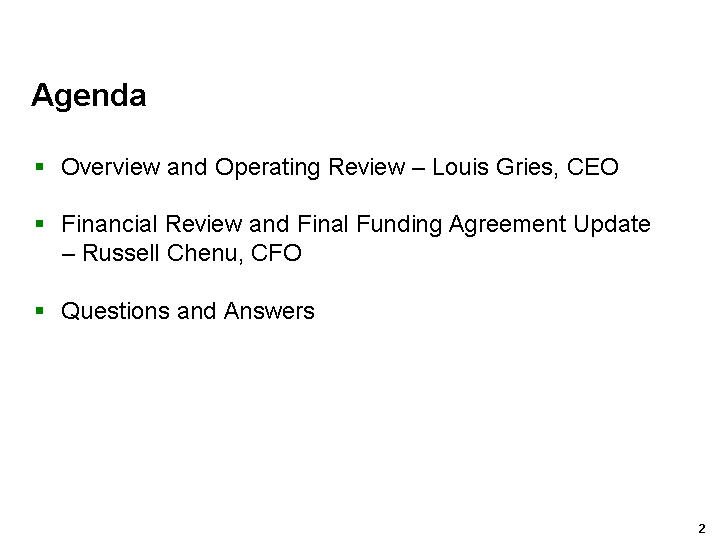
| Overview and Operating Review - Louis Gries, CEO Financial Review and Final Funding Agreement Update - Russell Chenu, CFO Questions and Answers Agenda |
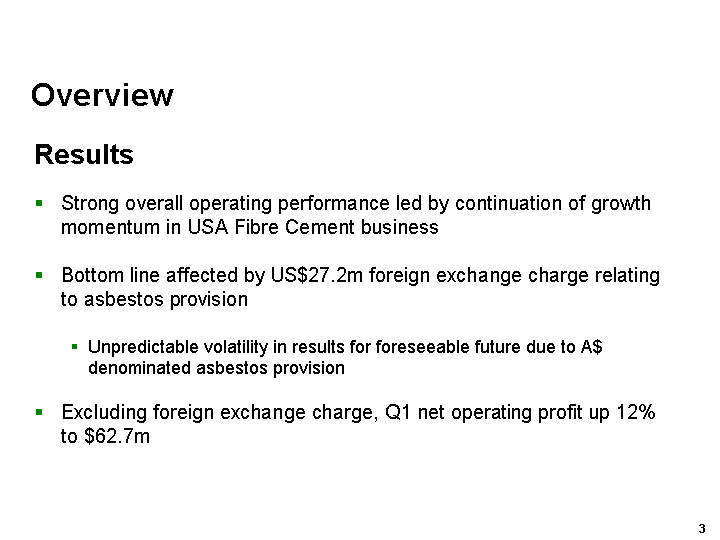
| Overview Results Strong overall operating performance led by continuation of growth momentum in USA Fibre Cement business Bottom line affected by US$27.2m foreign exchange charge relating to asbestos provision Unpredictable volatility in results for foreseeable future due to A$ denominated asbestos provision Excluding foreign exchange charge, Q1 net operating profit up 12% to $62.7m |
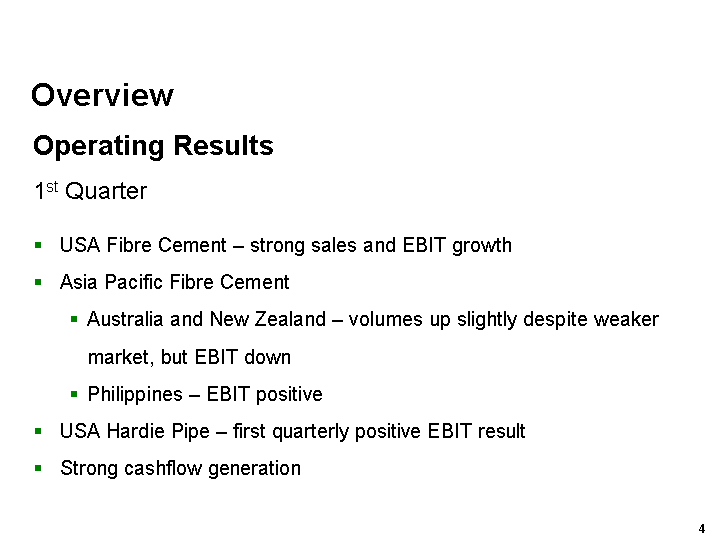
| Overview Operating Results 1st Quarter USA Fibre Cement - strong sales and EBIT growth Asia Pacific Fibre Cement Australia and New Zealand - volumes up slightly despite weaker market, but EBIT down Philippines - EBIT positive USA Hardie Pipe - first quarterly positive EBIT result Strong cashflow generation |
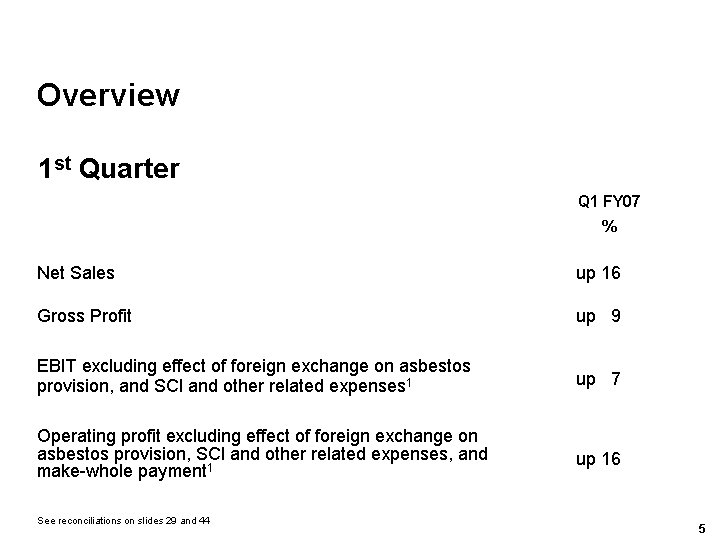
| Overview 1st Quarter Q1 FY07 % Net Sales up 16 Gross Profit up 9 EBIT excluding effect of foreign exchange on asbestos provision, and SCI and other related expenses1 up 7 Operating profit excluding effect of foreign exchange on asbestos provision, SCI and other related expenses, and make-whole payment1 up 16 See reconciliations on slides 29 and 44 |
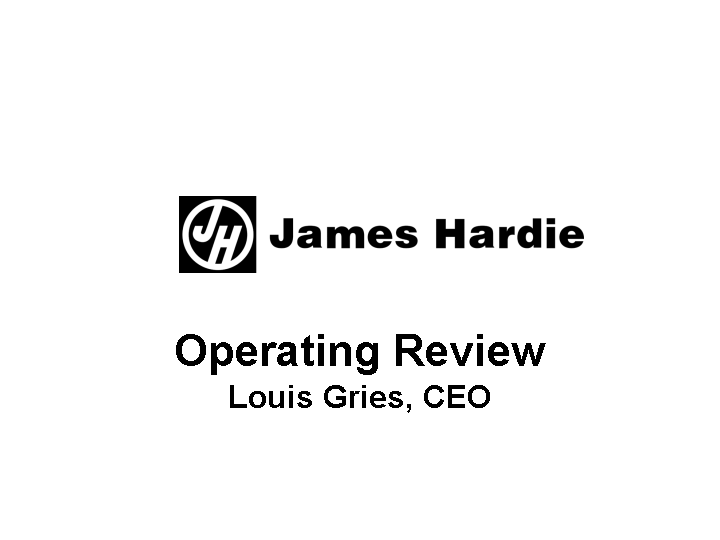
| Operating Review Louis Gries, CEO |

| USA Fibre Cement PHOTO |
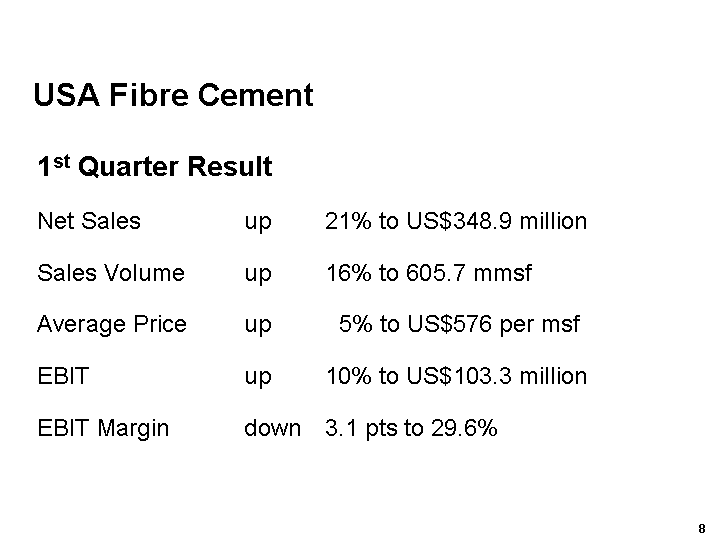
| 1st Quarter Result Net Sales up 21% to US$348.9 million Sales Volume up 16% to 605.7 mmsf Average Price up 5% to US$576 per msf EBIT up 10% to US$103.3 million EBIT Margin down 3.1 pts to 29.6% USA Fibre Cement |
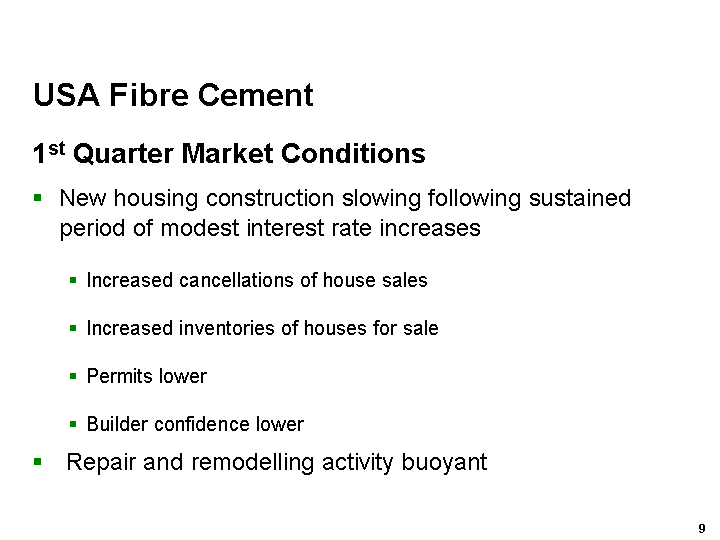
| USA Fibre Cement 1st Quarter Market Conditions New housing construction slowing following sustained period of modest interest rate increases Increased cancellations of house sales Increased inventories of houses for sale Permits lower Builder confidence lower Repair and remodelling activity buoyant |
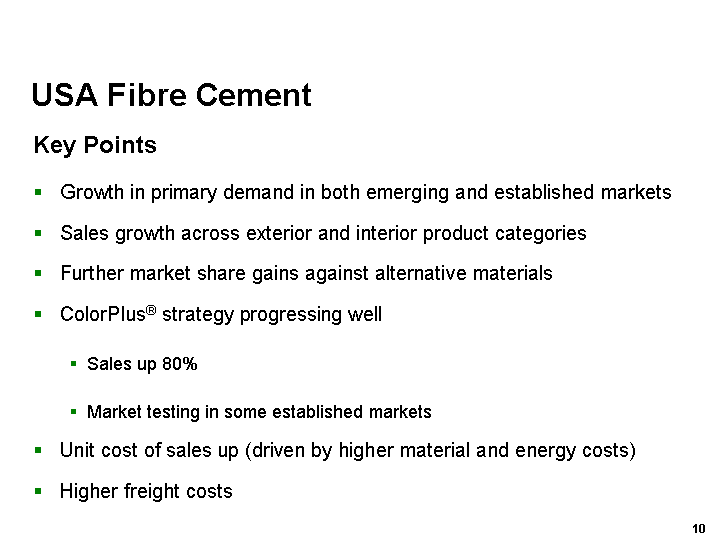
| USA Fibre Cement Key Points Growth in primary demand in both emerging and established markets Sales growth across exterior and interior product categories Further market share gains against alternative materials ColorPlus(r) strategy progressing well Sales up 80% Market testing in some established markets Unit cost of sales up (driven by higher material and energy costs) Higher freight costs |
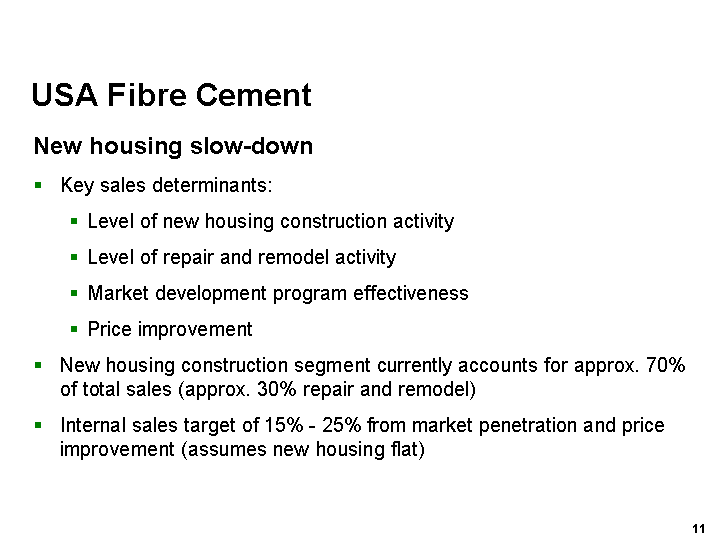
| USA Fibre Cement New housing slow-down Key sales determinants: Level of new housing construction activity Level of repair and remodel activity Market development program effectiveness Price improvement New housing construction segment currently accounts for approx. 70% of total sales (approx. 30% repair and remodel) Internal sales target of 15% - 25% from market penetration and price improvement (assumes new housing flat) |
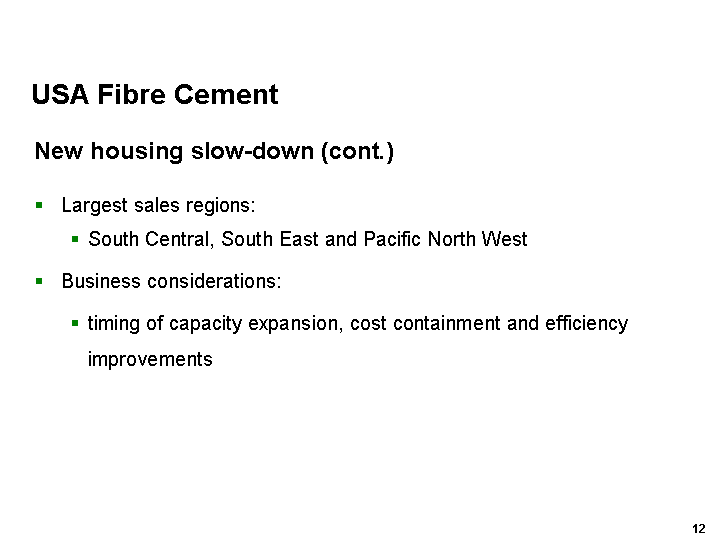
| USA Fibre Cement New housing slow-down (cont.) Largest sales regions: South Central, South East and Pacific North West Business considerations: timing of capacity expansion, cost containment and efficiency improvements |
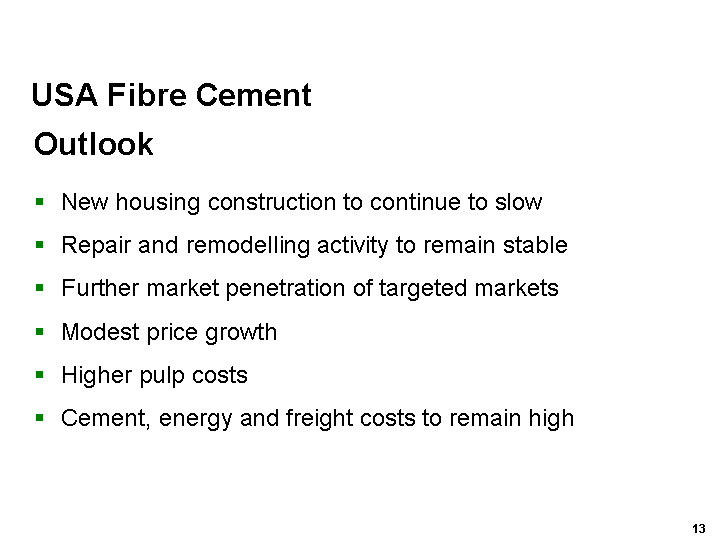
| USA Fibre Cement Outlook New housing construction to continue to slow Repair and remodelling activity to remain stable Further market penetration of targeted markets Modest price growth Higher pulp costs Cement, energy and freight costs to remain high |
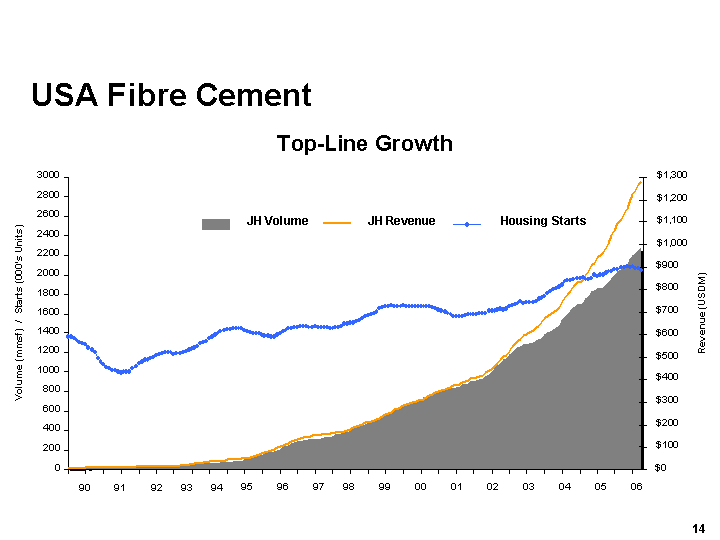
| USA Fibre Cement Top-Line Growth 0 200 400 600 800 1000 1200 1400 1600 1800 2000 2200 2400 2600 2800 3000 90 91 92 93 94 95 96 97 98 99 00 01 02 03 04 05 06 Volume (mmsf) / Starts (000's Units) $0 $100 $200 $300 $400 $500 $600 $700 $800 $900 $1,000 $1,100 $1,200 $1,300 Revenue (USDM) JH Volume JH Revenue Housing Starts |
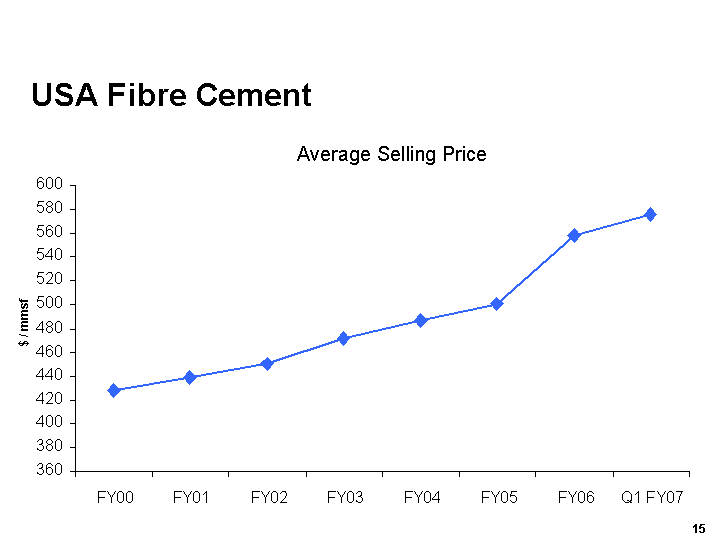
| USA Fibre Cement $ / mmsf 360 380 400 420 440 460 480 500 520 540 560 580 600 FY00 FY01 FY02 FY03 FY04 FY05 FY06 Q1 FY07 Average Selling Price |
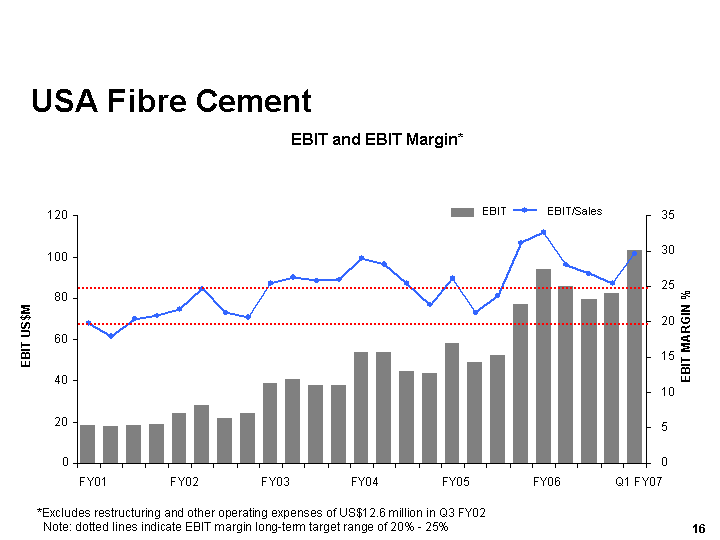
| USA Fibre Cement *Excludes restructuring and other operating expenses of US$12.6 million in Q3 FY02 Note: dotted lines indicate EBIT margin long-term target range of 20% - 25% |
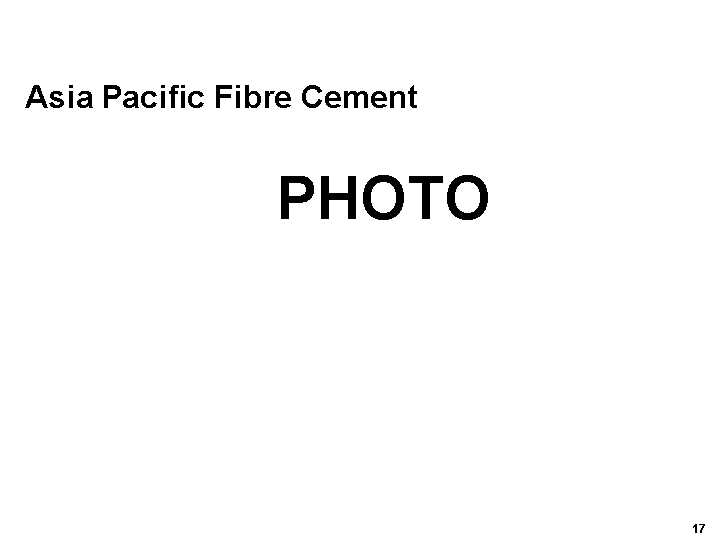
| Asia Pacific Fibre Cement PHOTO |
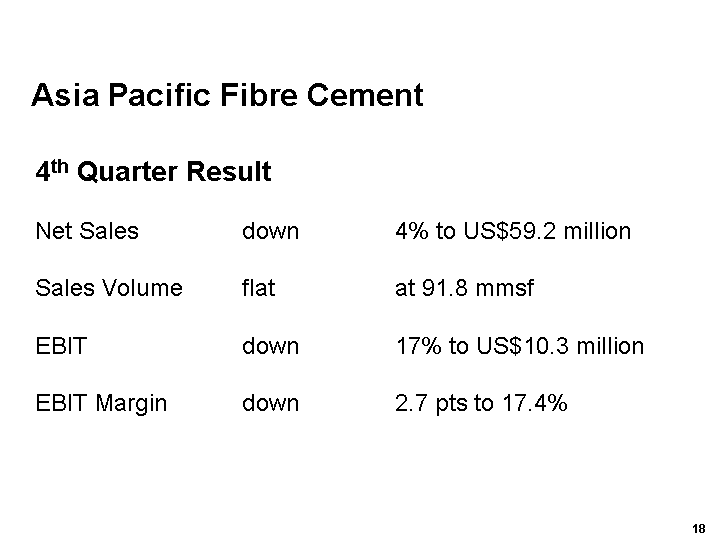
| Asia Pacific Fibre Cement 4th Quarter Result Net Sales down 4% to US$59.2 million Sales Volume flat at 91.8 mmsf EBIT down 17% to US$10.3 million EBIT Margin down 2.7 pts to 17.4% |
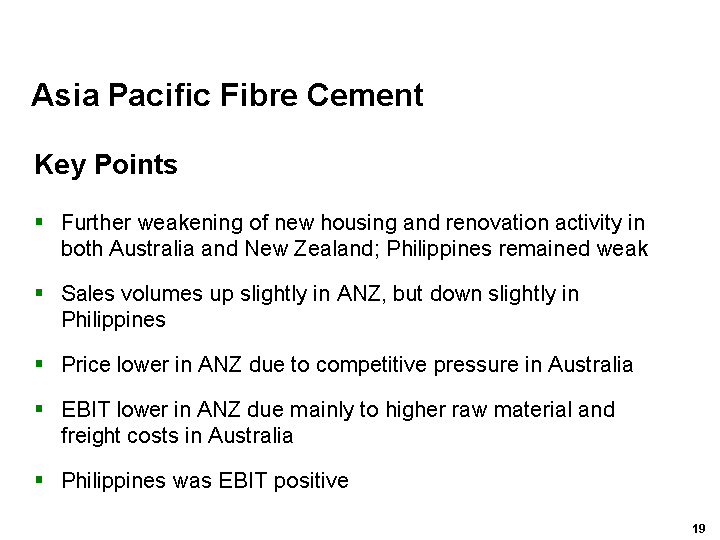
| Asia Pacific Fibre Cement Key Points Further weakening of new housing and renovation activity in both Australia and New Zealand; Philippines remained weak Sales volumes up slightly in ANZ, but down slightly in Philippines Price lower in ANZ due to competitive pressure in Australia EBIT lower in ANZ due mainly to higher raw material and freight costs in Australia Philippines was EBIT positive |
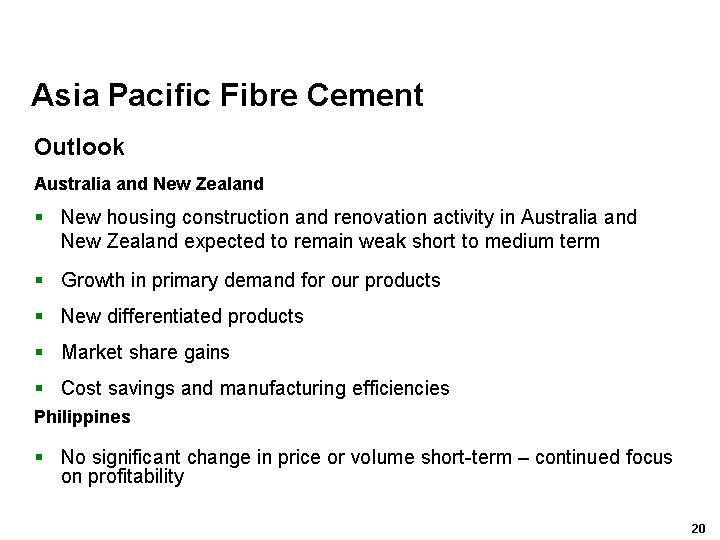
| Asia Pacific Fibre Cement Outlook Australia and New Zealand New housing construction and renovation activity in Australia and New Zealand expected to remain weak short to medium term Growth in primary demand for our products New differentiated products Market share gains Cost savings and manufacturing efficiencies Philippines No significant change in price or volume short-term - continued focus on profitability |

| Other USA Hardie Pipe - Key Points Increased net sales - both volume and price up Continued focus on manufacturing performance Pulp and cement costs up First EBIT positive quarter |
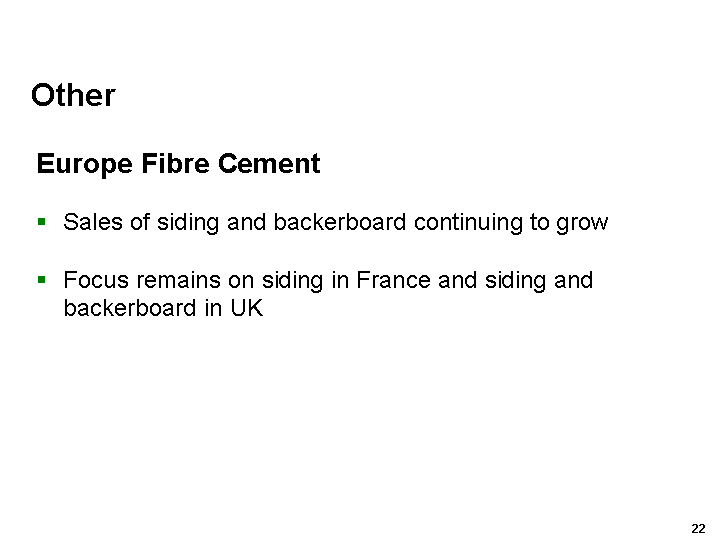
| Other Europe Fibre Cement Sales of siding and backerboard continuing to grow Focus remains on siding in France and siding and backerboard in UK |
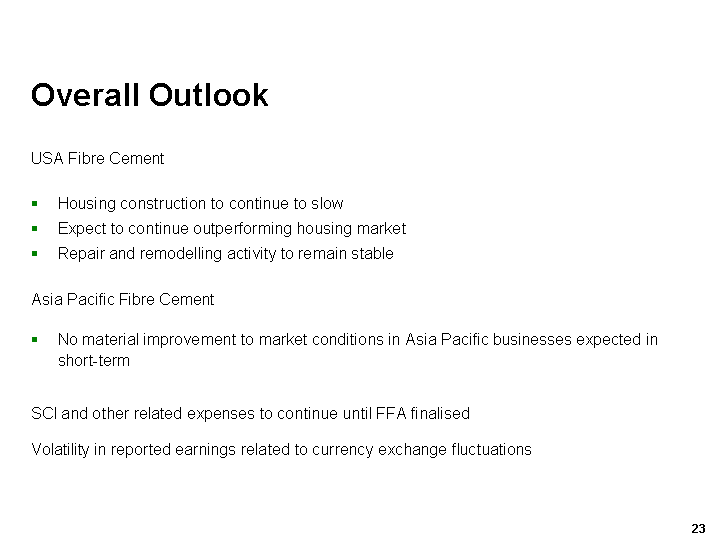
| Overall Outlook USA Fibre Cement Housing construction to continue to slow Expect to continue outperforming housing market Repair and remodelling activity to remain stable Asia Pacific Fibre Cement No material improvement to market conditions in Asia Pacific businesses expected in short-term SCI and other related expenses to continue until FFA finalised Volatility in reported earnings related to currency exchange fluctuations |

| Financial Review and Final Funding Agreement Update Russell Chenu, CFO |
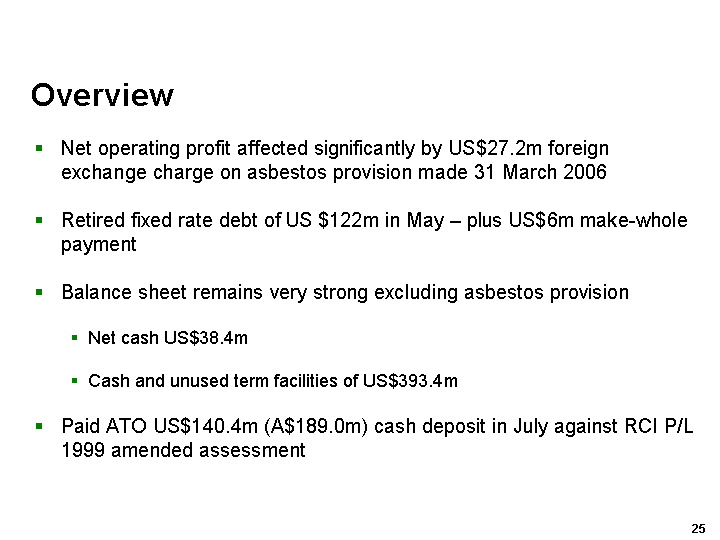
| Overview Net operating profit affected significantly by US$27.2m foreign exchange charge on asbestos provision made 31 March 2006 Retired fixed rate debt of US $122m in May - plus US$6m make-whole payment Balance sheet remains very strong excluding asbestos provision Net cash US$38.4m Cash and unused term facilities of US$393.4m Paid ATO US$140.4m (A$189.0m) cash deposit in July against RCI P/L 1999 amended assessment |
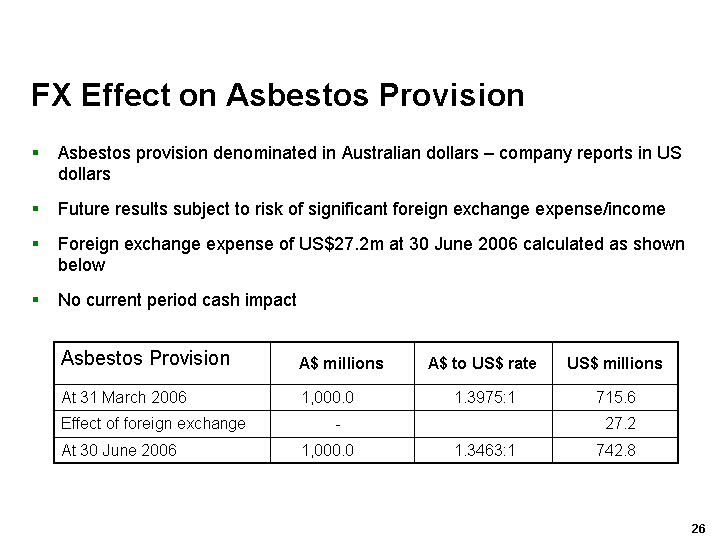
| FX Effect on Asbestos Provision Asbestos provision denominated in Australian dollars - company reports in US dollars Future results subject to risk of significant foreign exchange expense/income Foreign exchange expense of US$27.2m at 30 June 2006 calculated as shown below No current period cash impact Asbestos Provision A$ millions A$ to US$ rate US$ millions At 31 March 2006 1,000.0 1.3975:1 715.6 Effect of foreign exchange - 27.2 At 30 June 2006 1,000.0 1.3463:1 742.8 |
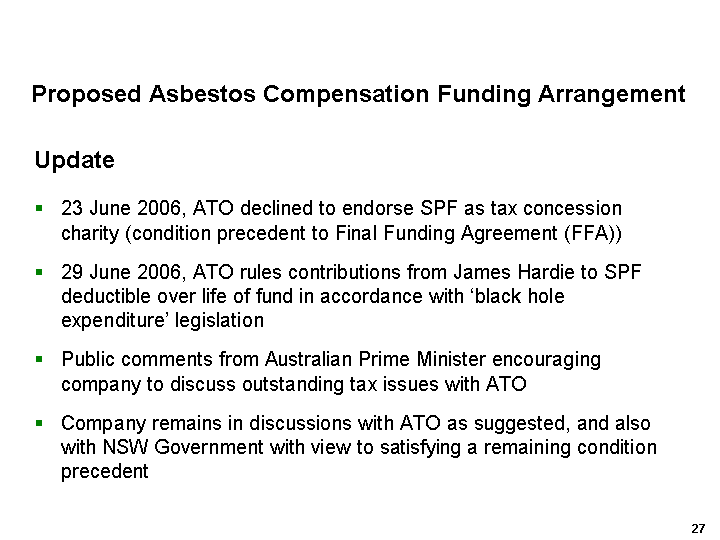
| Proposed Asbestos Compensation Funding Arrangement Update 23 June 2006, ATO declined to endorse SPF as tax concession charity (condition precedent to Final Funding Agreement (FFA)) 29 June 2006, ATO rules contributions from James Hardie to SPF deductible over life of fund in accordance with 'black hole expenditure' legislation Public comments from Australian Prime Minister encouraging company to discuss outstanding tax issues with ATO Company remains in discussions with ATO as suggested, and also with NSW Government with view to satisfying a remaining condition precedent |
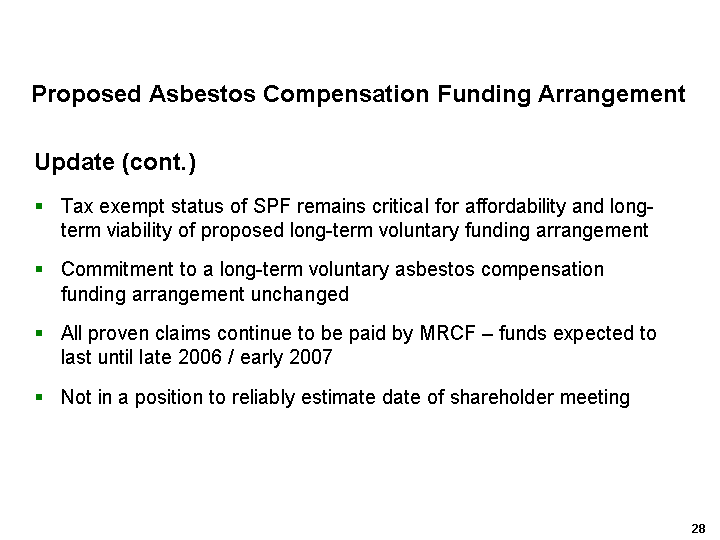
| Update (cont.) Tax exempt status of SPF remains critical for affordability and long- term viability of proposed long-term voluntary funding arrangement Commitment to a long-term voluntary asbestos compensation funding arrangement unchanged All proven claims continue to be paid by MRCF - funds expected to last until late 2006 / early 2007 Not in a position to reliably estimate date of shareholder meeting Proposed Asbestos Compensation Funding Arrangement |
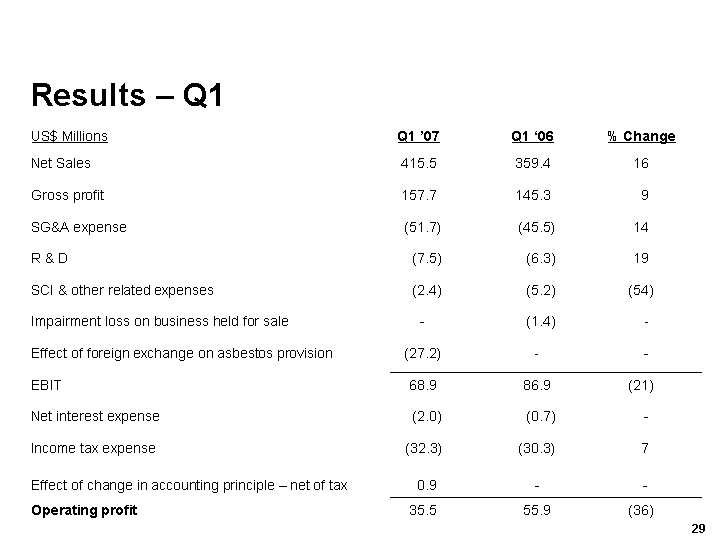
| Results - Q1 US$ Millions Q1 '07 Q1 '06 % Change Net Sales 415.5 359.4 16 Gross profit 157.7 145.3 9 SG&A expense (51.7) (45.5) 14 R & D (7.5) (6.3) 19 SCI & other related expenses (2.4) (5.2) (54) Impairment loss on business held for sale - (1.4) - Effect of foreign exchange on asbestos provision (27.2) - - EBIT 68.9 86.9 (21) Net interest expense (2.0) (0.7) - Income tax expense Effect of change in accounting principle - net of tax (32.3) 0.9 (30.3) - 7 - Operating profit 35.5 55.9 (36) |
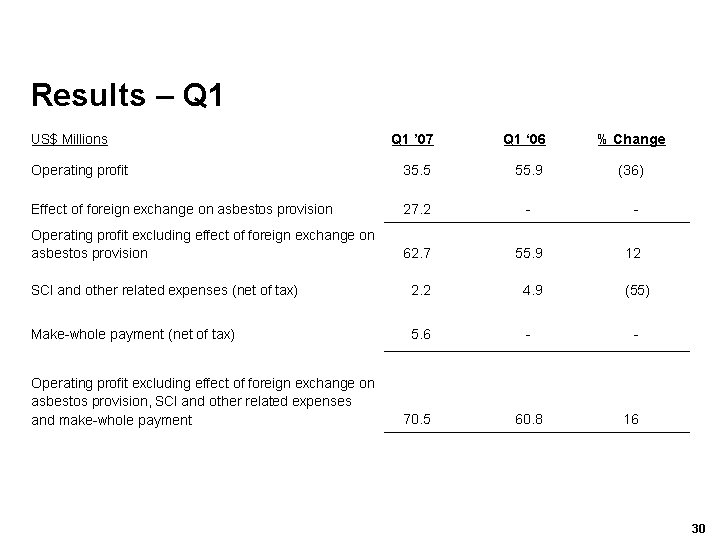
| Results - Q1 US$ Millions Q1 '07 Q1 '06 % Change Operating profit 35.5 55.9 (36) Effect of foreign exchange on asbestos provision 27.2 - - Operating profit excluding effect of foreign exchange on asbestos provision SCI and other related expenses (net of tax) 62.7 2.2 55.9 4.9 12 (55) Make-whole payment (net of tax) 5.6 - - Operating profit excluding effect of foreign exchange on asbestos provision, SCI and other related expenses and make-whole payment 70.5 60.8 16 |
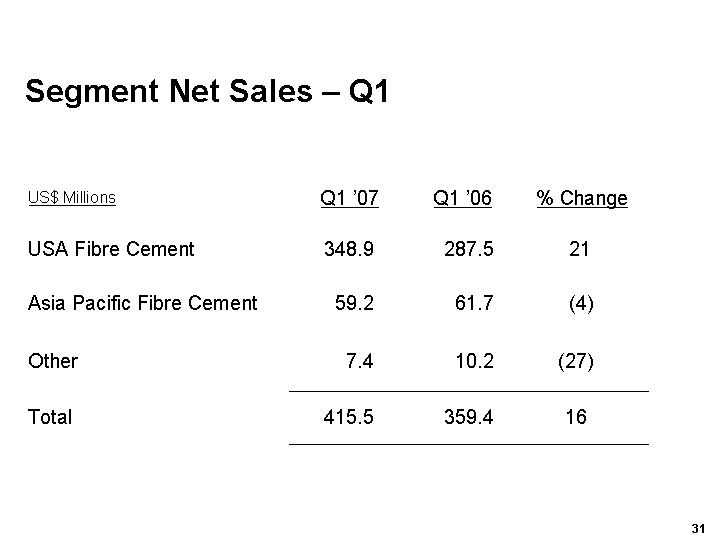
| Segment Net Sales - Q1 US$ Millions Q1 '07 Q1 '06 % Change USA Fibre Cement 348.9 287.5 21 Asia Pacific Fibre Cement 59.2 61.7 (4) Other 7.4 10.2 (27) Total 415.5 359.4 16 |
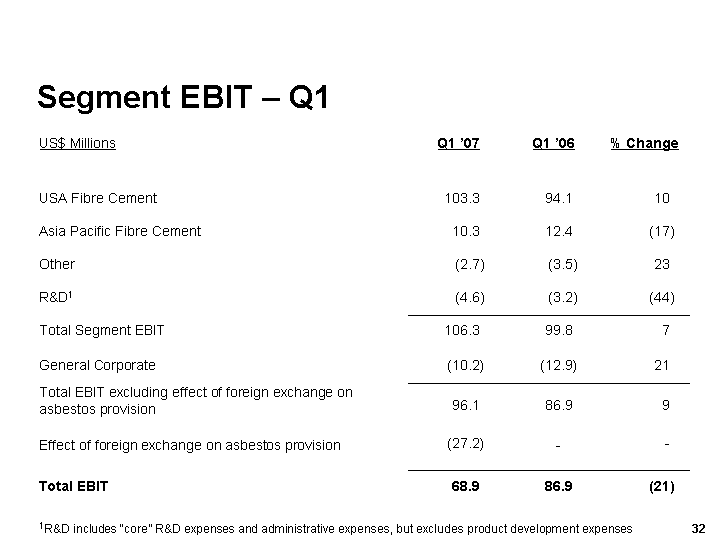
| Segment EBIT - Q1 US$ Millions Q1 '07 Q1 '06 % Change USA Fibre Cement 103.3 94.1 10 Asia Pacific Fibre Cement 10.3 12.4 (17) Other (2.7) (3.5) 23 R&D1 (4.6) (3.2) (44) Total Segment EBIT 106.3 99.8 7 General Corporate (10.2) (12.9) 21 Total EBIT excluding effect of foreign exchange on asbestos provision 96.1 86.9 9 Effect of foreign exchange on asbestos provision (27.2) - - Total EBIT 68.9 86.9 (21) 1R&D includes "core" R&D expenses and administrative expenses, but excludes product development expenses |
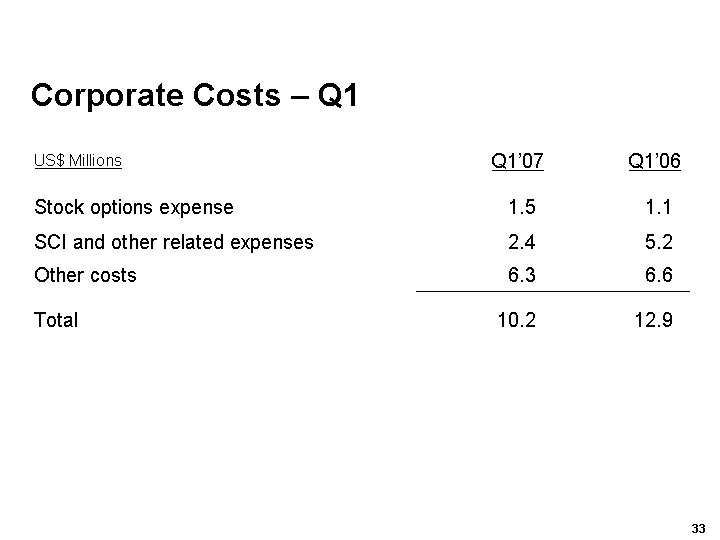
| Corporate Costs - Q1 US$ Millions Q1'07 Q1'06 Stock options expense 1.5 1.1 SCI and other related expenses 2.4 5.2 Other costs 6.3 6.6 Total 10.2 12.9 |
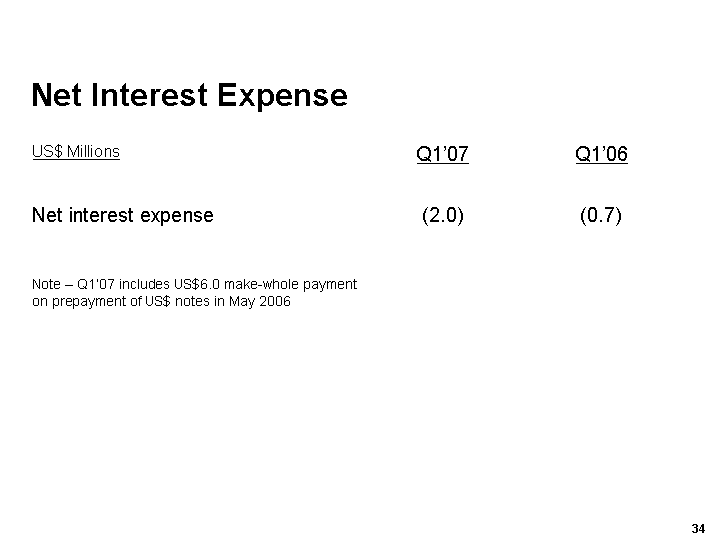
| Net Interest Expense US$ Millions Q1'07 Q1'06 Net interest expense Note - Q1'07 includes US$6.0 make-whole payment on prepayment of US$ notes in May 2006 (2.0) (0.7) |
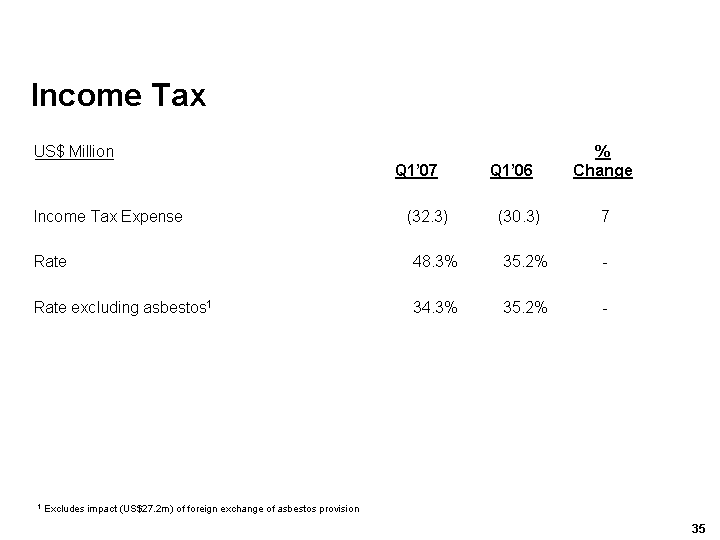
| Income Tax US$ Million Q1'07 Q1'06 % Change Income Tax Expense (32.3) (30.3) 7 Rate 48.3% 35.2% - Rate excluding asbestos1 34.3% 35.2% - 1 Excludes impact (US$27.2m) of foreign exchange of asbestos provision |
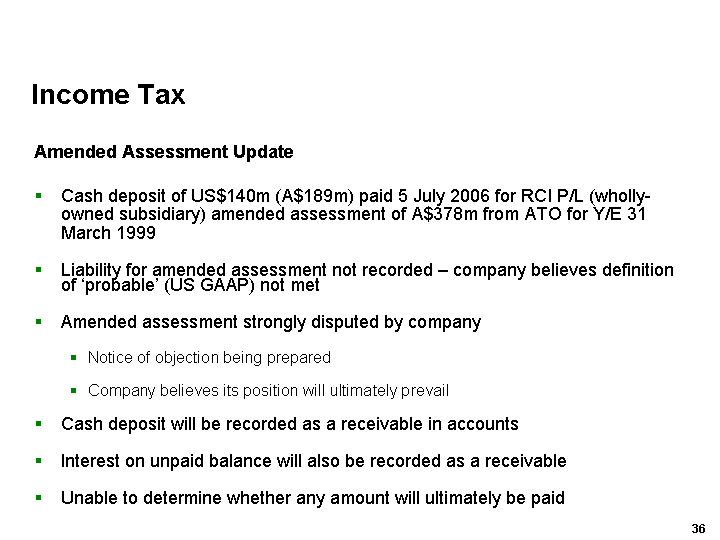
| Income Tax Amended Assessment Update Cash deposit of US$140m (A$189m) paid 5 July 2006 for RCI P/L (wholly- owned subsidiary) amended assessment of A$378m from ATO for Y/E 31 March 1999 Liability for amended assessment not recorded - company believes definition of 'probable' (US GAAP) not met Amended assessment strongly disputed by company Notice of objection being prepared Company believes its position will ultimately prevail Cash deposit will be recorded as a receivable in accounts Interest on unpaid balance will also be recorded as a receivable Unable to determine whether any amount will ultimately be paid |
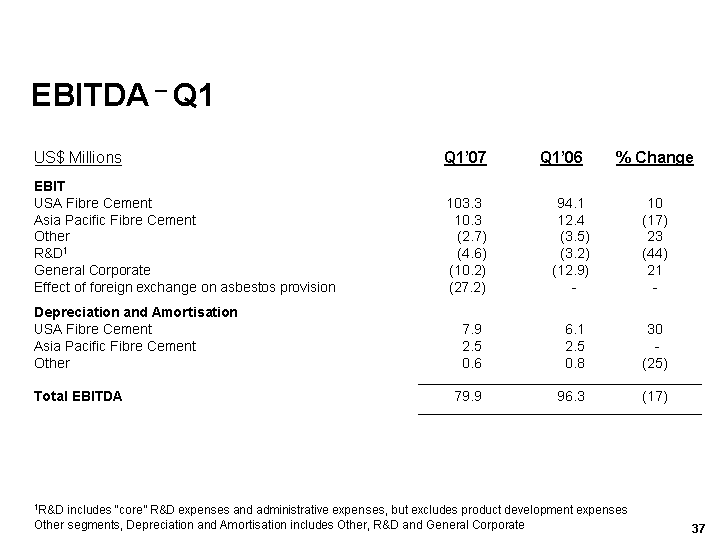
| EBITDA - Q1 US$ Millions Q1'07 Q1'06 % Change EBIT USA Fibre Cement Asia Pacific Fibre Cement Other R&D1 General Corporate Effect of foreign exchange on asbestos provision 103.3 10.3 (2.7) (4.6) (10.2) (27.2) 94.1 12.4 (3.5) (3.2) (12.9) - 10 (17) 23 (44) 21 - - Depreciation and Amortisation USA Fibre Cement Asia Pacific Fibre Cement Other 7.9 2.5 0.6 6.1 2.5 0.8 30 - (25) Total EBITDA 79.9 96.3 (17) 1R&D includes "core" R&D expenses and administrative expenses, but excludes product development expenses Other segments, Depreciation and Amortisation includes Other, R&D and General Corporate |
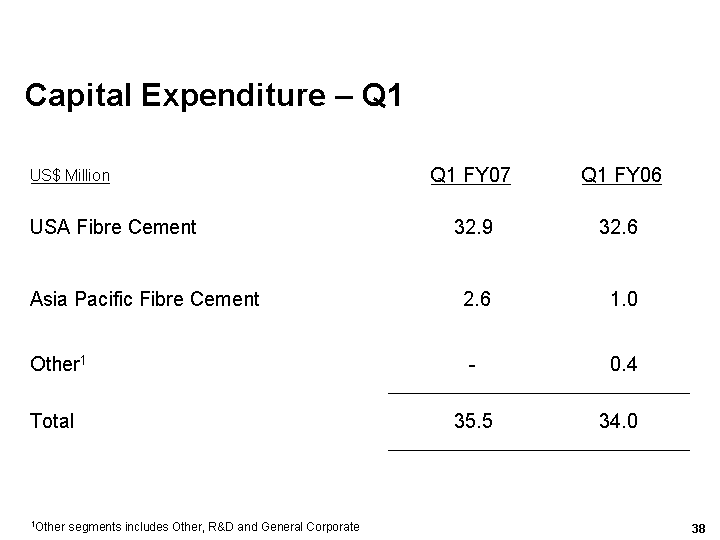
| Capital Expenditure - Q1 US$ Million Q1 FY07 Q1 FY06 USA Fibre Cement 32.9 32.6 Asia Pacific Fibre Cement 2.6 1.0 Other1 - 0.4 Total 35.5 34.0 1Other segments includes Other, R&D and General Corporate |

| Key Ratios Q1FY07 FY06 FY05 EPS (Diluted)1 13.4c 44.9c 27.7c Dividend paid per share - 10.0c 3.0c Return on Shareholders' Funds1 2 29.3% 29.6% 22.4% Return on Capital Employed1 2 38.2% 28.9% 23.6% EBIT/ Sales (EBIT margin)1 23.1% 18.9% 16.2% Gearing Ratio - - 6.8% Net Interest Expense Cover1 46.4x - 38.5x Net Interest Paid Cover1 17.4x 89.0x 18.3x Net Debt Payback - - 2.5 mths 1 Excluding in FY07 effect of foreign exchange on asbestos provision and in FY06 asbestos provision 2 Return on Shareholders' Funds and Return on Capital Employed are both annualised |
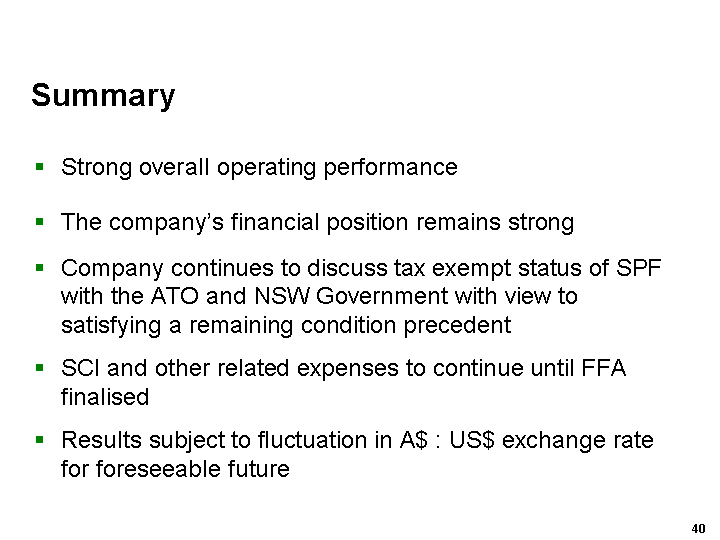
| Summary Strong overall operating performance The company's financial position remains strong Company continues to discuss tax exempt status of SPF with the ATO and NSW Government with view to satisfying a remaining condition precedent SCI and other related expenses to continue until FFA finalised Results subject to fluctuation in A$ : US$ exchange rate for foreseeable future |

| Questions & Answers |

| Endnotes DEFINITIONS Financial Measures - US GAAP equivalents EBIT and EBIT margin - EBIT is equivalent to the US GAAP measure of operating income. EBIT margin is defined as EBIT as a percentage of net sales. James Hardie believes EBIT and EBIT margin to be relevant and useful information as these are the primary measures used by management to measure the operating profit or loss of its business. EBIT is one of several metrics used by management to measure the earnings generated by the company's operations, excluding interest and income tax expenses. Additionally, EBIT is believed to be a primary measure and terminology used by its Australian investors. EBIT and EBIT margin should be considered in addition to, but not as a substitute for, other measures of financial performance reported in accordance with accounting principles generally accepted in the United States of America. EBIT and EBIT margin, as the company has defined them, may not be comparable to similarly titled measures reported by other companies. Operating profit - is equivalent to the US GAAP measure of income. Net operating profit - is equivalent to the US GAAP measure of net income. |
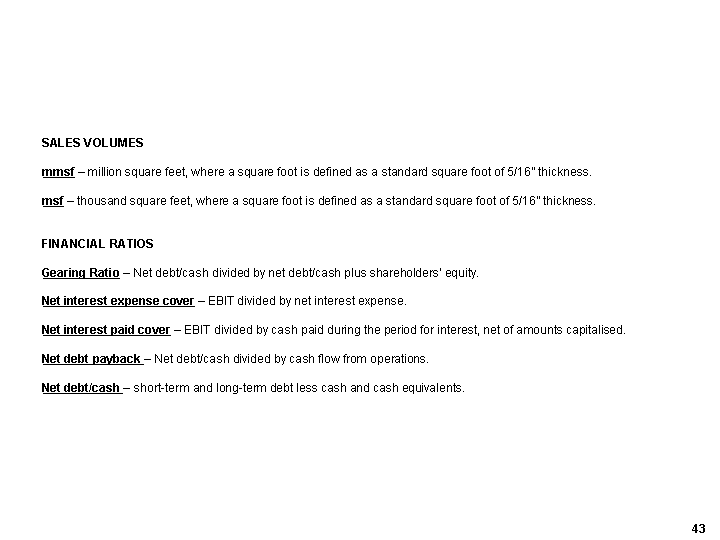
| SALES VOLUMES mmsf - million square feet, where a square foot is defined as a standard square foot of 5/16" thickness. msf - thousand square feet, where a square foot is defined as a standard square foot of 5/16" thickness. FINANCIAL RATIOS Gearing Ratio - Net debt/cash divided by net debt/cash plus shareholders' equity. Net interest expense cover - EBIT divided by net interest expense. Net interest paid cover - EBIT divided by cash paid during the period for interest, net of amounts capitalised. Net debt payback - Net debt/cash divided by cash flow from operations. Net debt/cash - short-term and long-term debt less cash and cash equivalents. |

| NON-US GAAP FINANCIAL MEASURES EBIT and EBIT margin excluding effect of foreign exchange on asbestos provision - EBIT and EBIT margin excluding effect of foreign exchange on asbestos provision are not measures of financial performance under US GAAP and should not be considered to be more meaningful than EBIT and EBIT margin. James Hardie has included these financial measures to provide investors with an alternative method for assessing its operating results in a manner that is focussed on the performance of its ongoing operations and provides useful information regarding its financial condition and results of operations. The company uses these non-US GAAP measures for the same purposes. US$ Million Q1 FY07 Q1 FY06 EBIT $ 68.9 $ 86.9 Effect of foreign exchange on asbestos provision 27.2 - EBIT excluding effect of foreign exchange on asbestos provision 96.1 86.9 Net Sales $415.5 $359.4 EBIT margin excluding effect of foreign exchange on asbestos provision 23.1% 24.2% |
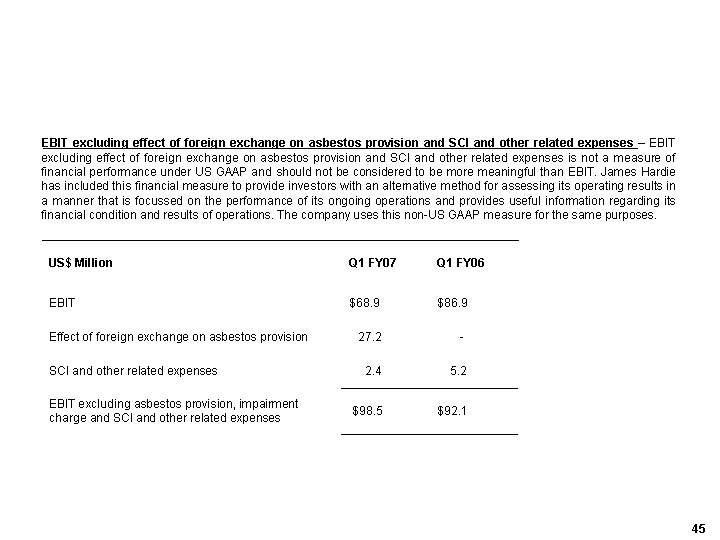
| EBIT excluding effect of foreign exchange on asbestos provision and SCI and other related expenses - EBIT excluding effect of foreign exchange on asbestos provision and SCI and other related expenses is not a measure of financial performance under US GAAP and should not be considered to be more meaningful than EBIT. James Hardie has included this financial measure to provide investors with an alternative method for assessing its operating results in a manner that is focussed on the performance of its ongoing operations and provides useful information regarding its financial condition and results of operations. The company uses this non-US GAAP measure for the same purposes. US$ Million Q1 FY07 Q1 FY06 EBIT $68.9 $86.9 Effect of foreign exchange on asbestos provision 27.2 - SCI and other related expenses 2.4 5.2 EBIT excluding asbestos provision, impairment charge and SCI and other related expenses $98.5 $92.1 |
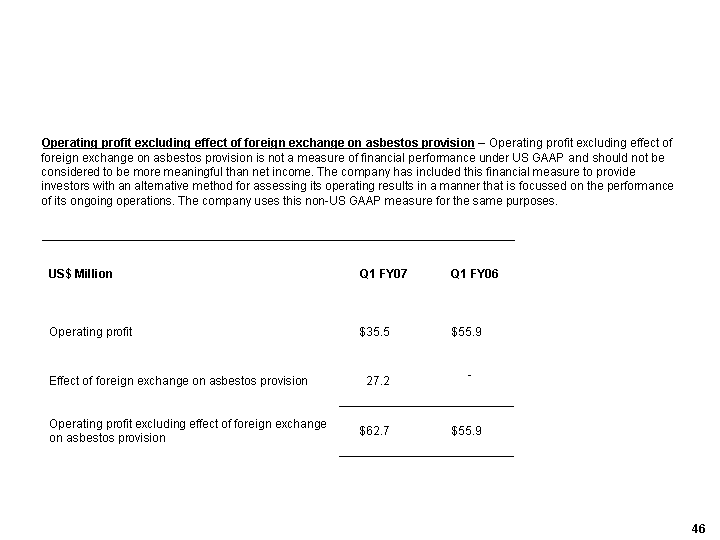
| Operating profit excluding effect of foreign exchange on asbestos provision - Operating profit excluding effect of foreign exchange on asbestos provision is not a measure of financial performance under US GAAP and should not be considered to be more meaningful than net income. The company has included this financial measure to provide investors with an alternative method for assessing its operating results in a manner that is focussed on the performance of its ongoing operations. The company uses this non-US GAAP measure for the same purposes. US$ Million Q1 FY07 Q1 FY06 Operating profit $35.5 $55.9 Effect of foreign exchange on asbestos provision 27.2 - Operating profit excluding effect of foreign exchange on asbestos provision $62.7 $55.9 |

| Diluted earnings per share excluding effect of foreign exchange on asbestos provision - Diluted earnings per share excluding effect of foreign exchange on asbestos is not a measure of financial performance under US GAAP and should not be considered to be more meaningful than diluted earnings per share. The company has included this financial measure to provide investors with an alternative method for assessing its operating results in a manner that is focussed on the performance of its ongoing operations. The company's management uses this non-US GAAP measure for the same purposes. US$ Million Q1 FY07 Q1 FY06 Operating profit $ 35.5 $ 55.9 Effect of foreign exchange on asbestos provision 27.2 - Operating profit excluding effect of foreign exchange on asbestos provision 62.7 55.9 Weighted average common shares outstanding (Millions) - Diluted 466.9 462.7 Diluted earnings per share excluding effect of foreign exchange on asbestos provision (US cents) 13.4 12.1 |
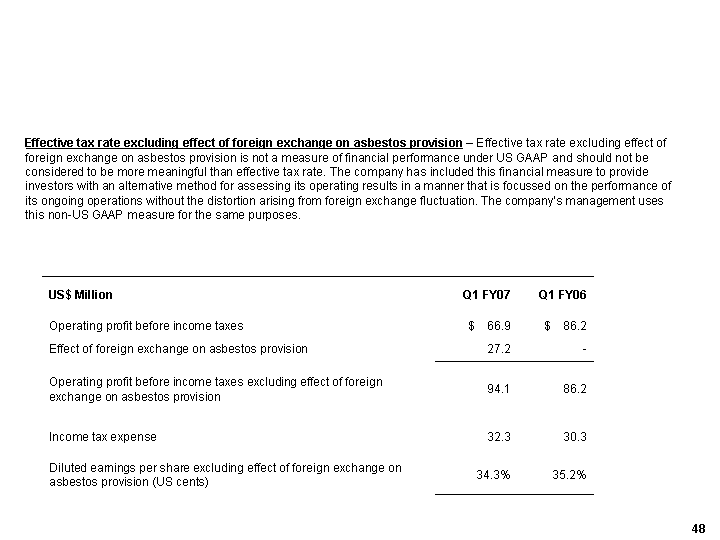
| Effective tax rate excluding effect of foreign exchange on asbestos provision - Effective tax rate excluding effect of foreign exchange on asbestos provision is not a measure of financial performance under US GAAP and should not be considered to be more meaningful than effective tax rate. The company has included this financial measure to provide investors with an alternative method for assessing its operating results in a manner that is focussed on the performance of its ongoing operations without the distortion arising from foreign exchange fluctuation. The company's management uses this non-US GAAP measure for the same purposes. US$ Million Q1 FY07 Q1 FY06 Operating profit before income taxes $ 66.9 $ 86.2 Effect of foreign exchange on asbestos provision 27.2 - Operating profit before income taxes excluding effect of foreign exchange on asbestos provision 94.1 86.2 Income tax expense 32.3 30.3 Diluted earnings per share excluding effect of foreign exchange on asbestos provision (US cents) 34.3% 35.2% |
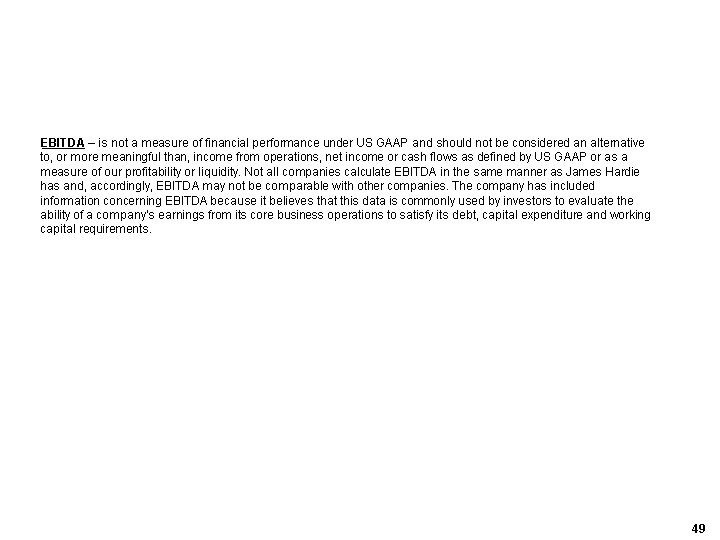
| EBITDA - is not a measure of financial performance under US GAAP and should not be considered an alternative to, or more meaningful than, income from operations, net income or cash flows as defined by US GAAP or as a measure of our profitability or liquidity. Not all companies calculate EBITDA in the same manner as James Hardie has and, accordingly, EBITDA may not be comparable with other companies. The company has included information concerning EBITDA because it believes that this data is commonly used by investors to evaluate the ability of a company's earnings from its core business operations to satisfy its debt, capital expenditure and working capital requirements. |
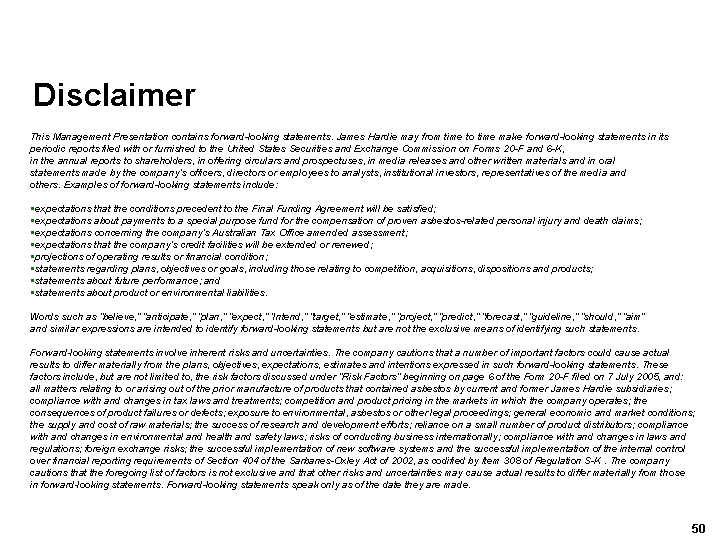
| Disclaimer This Management Presentation contains forward-looking statements. James Hardie may from time to time make forward-looking statements in its periodic reports filed with or furnished to the United States Securities and Exchange Commission on Forms 20-F and 6-K, in the annual reports to shareholders, in offering circulars and prospectuses, in media releases and other written materials and in oral statements made by the company's officers, directors or employees to analysts, institutional investors, representatives of the media and others. Examples of forward-looking statements include: expectations that the conditions precedent to the Final Funding Agreement will be satisfied; expectations about payments to a special purpose fund for the compensation of proven asbestos-related personal injury and death claims; expectations concerning the company's Australian Tax Office amended assessment; expectations that the company's credit facilities will be extended or renewed; projections of operating results or financial condition; statements regarding plans, objectives or goals, including those relating to competition, acquisitions, dispositions and products; statements about future performance; and statements about product or environmental liabilities. Words such as "believe," "anticipate," "plan," "expect," "intend," "target," "estimate," "project," "predict," "forecast," "guideline," "should," "aim" and similar expressions are intended to identify forward-looking statements but are not the exclusive means of identifying such statements. Forward-looking statements involve inherent risks and uncertainties. The company cautions that a number of important factors could cause actual results to differ materially from the plans, objectives, expectations, estimates and intentions expressed in such forward-looking statements. These factors include, but are not limited to, the risk factors discussed under "Risk Factors" beginning on page 6 of the Form 20-F filed on 7 July 2005, and: all matters relating to or arising out of the prior manufacture of products that contained asbestos by current and former James Hardie subsidiaries; compliance with and changes in tax laws and treatments; competition and product pricing in the markets in which the company operates; the consequences of product failures or defects; exposure to environmental, asbestos or other legal proceedings; general economic and market conditions; the supply and cost of raw materials; the success of research and development efforts; reliance on a small number of product distributors; compliance with and changes in environmental and health and safety laws; risks of conducting business internationally; compliance with and changes in laws and regulations; foreign exchange risks; the successful implementation of new software systems and the successful implementation of the internal control over financial reporting requirements of Section 404 of the Sarbanes-Oxley Act of 2002, as codified by Item 308 of Regulation S-K . The company cautions that the foregoing list of factors is not exclusive and that other risks and uncertainties may cause actual results to differ materially from those in forward-looking statements. Forward-looking statements speak only as of the date they are made. |